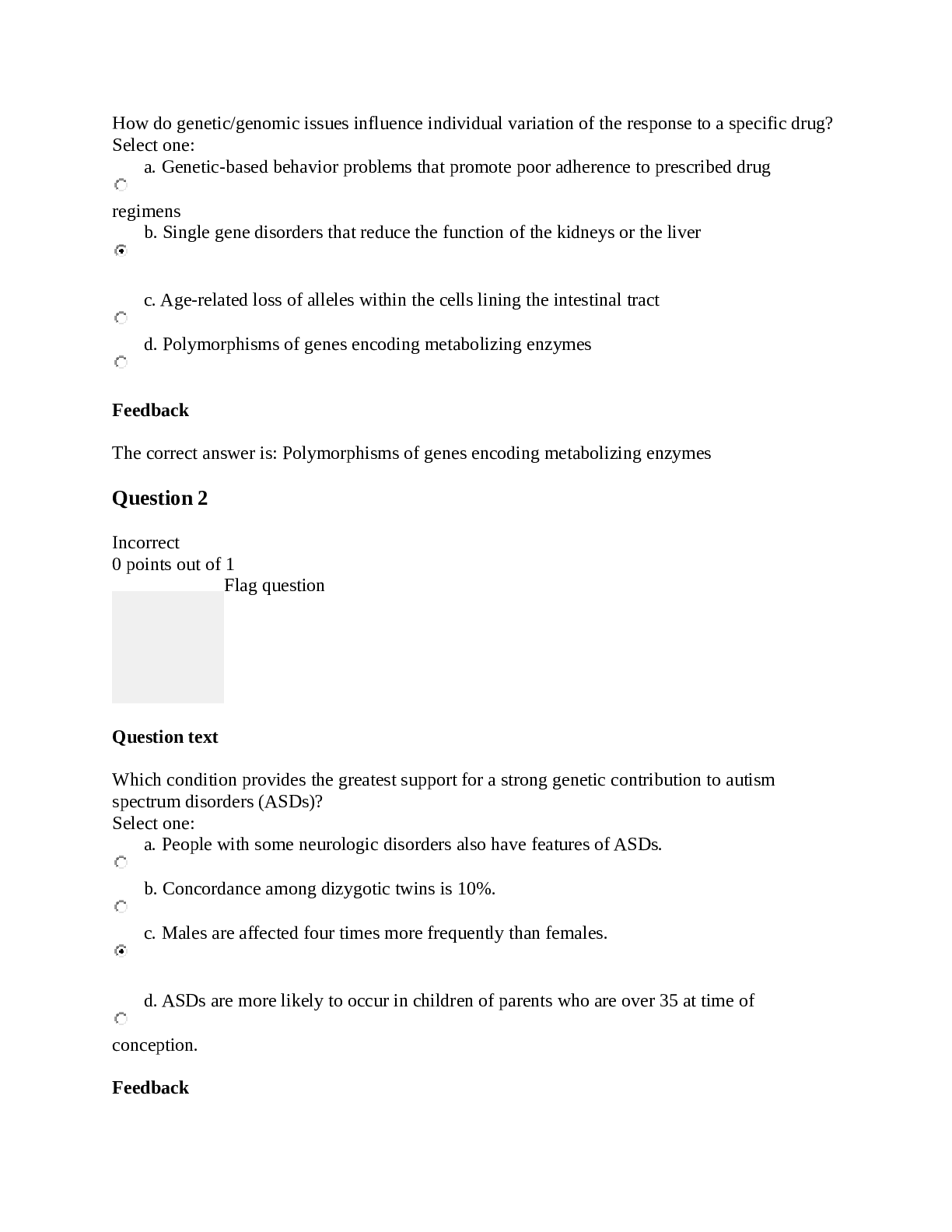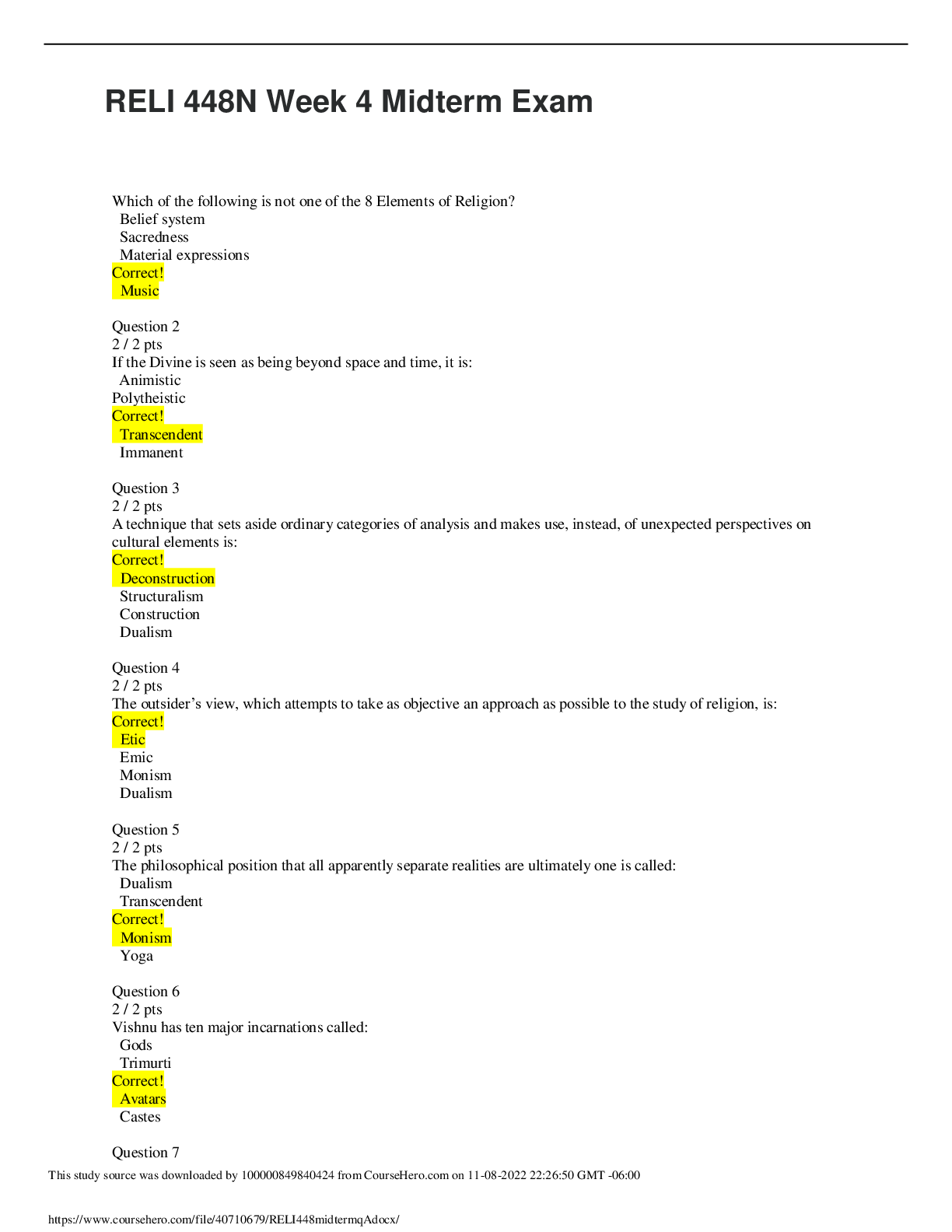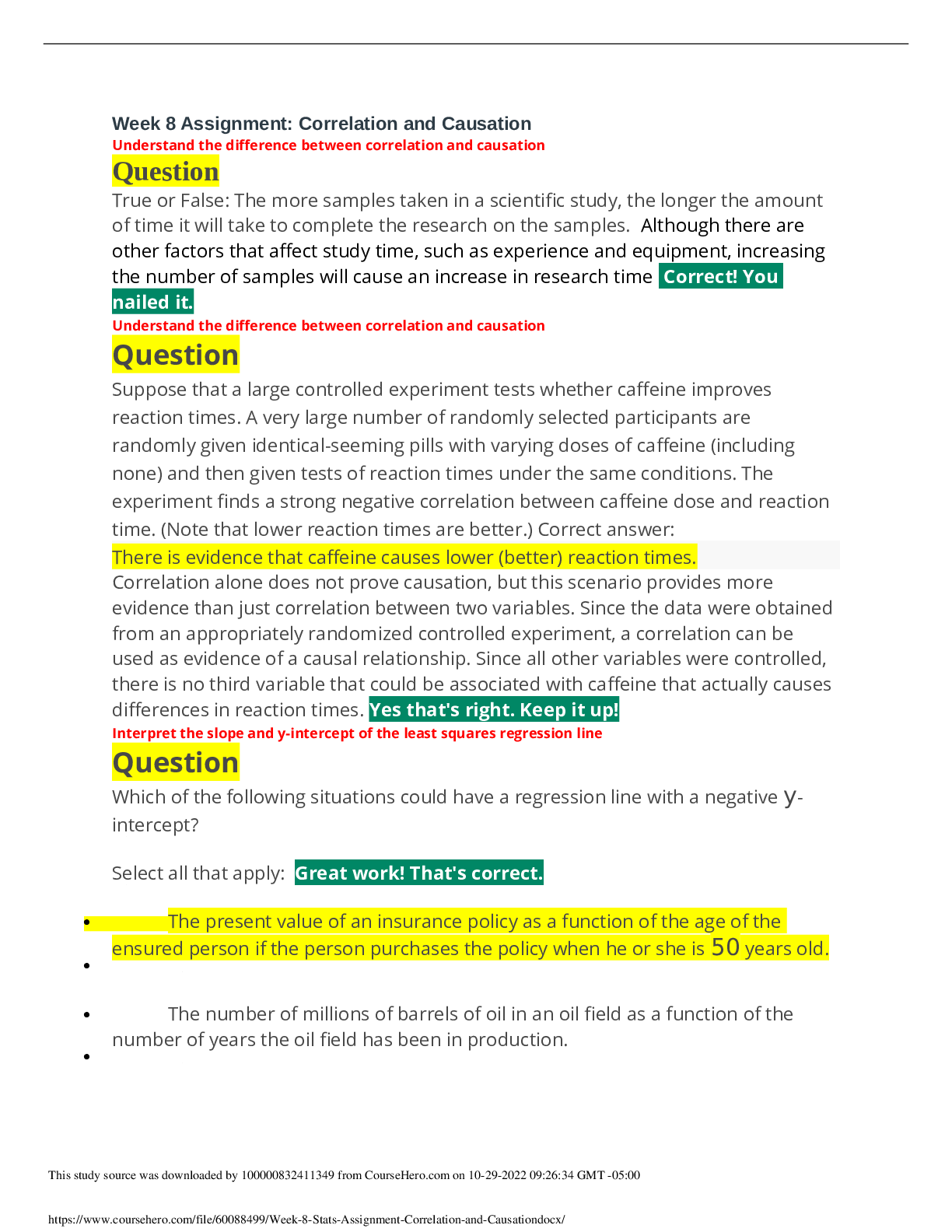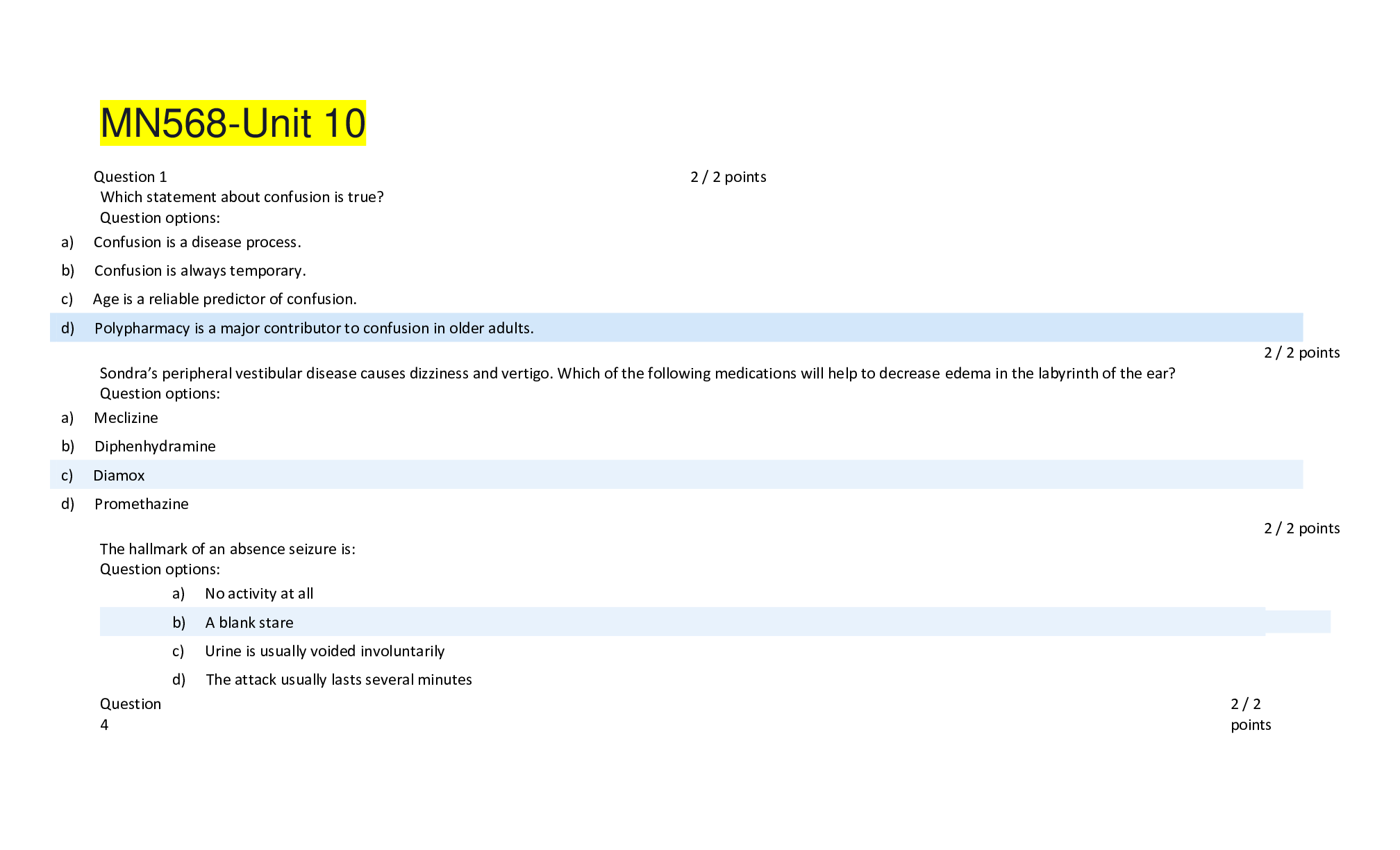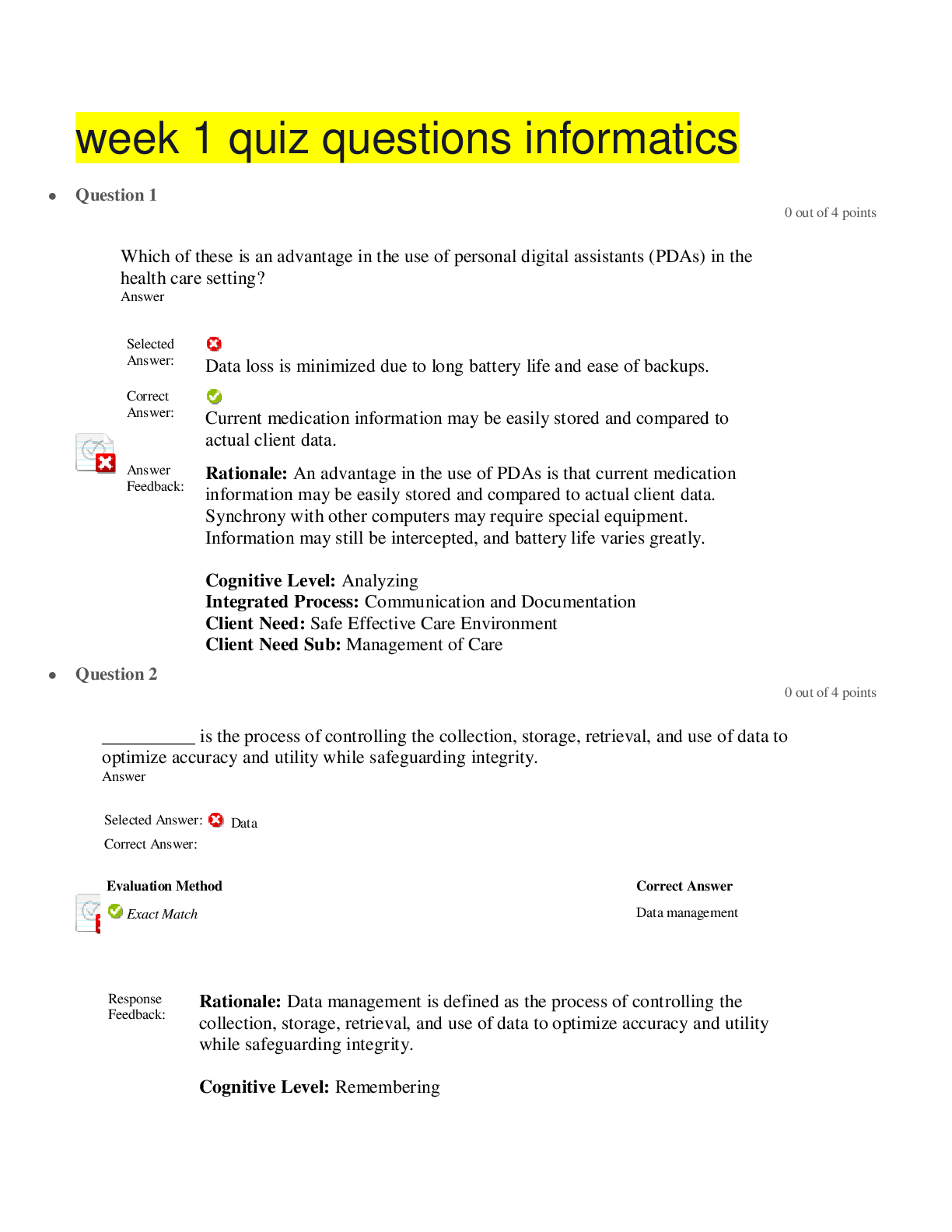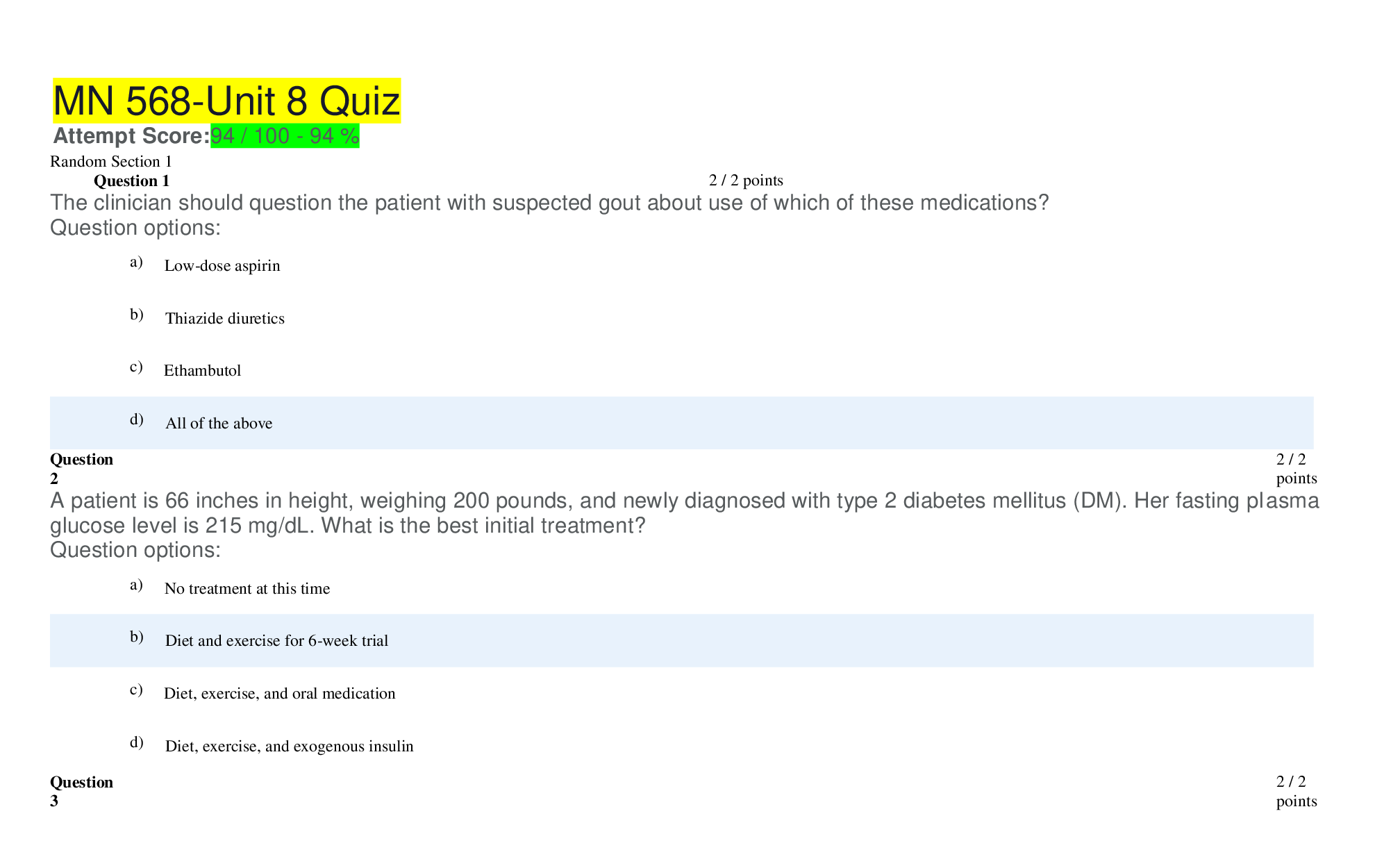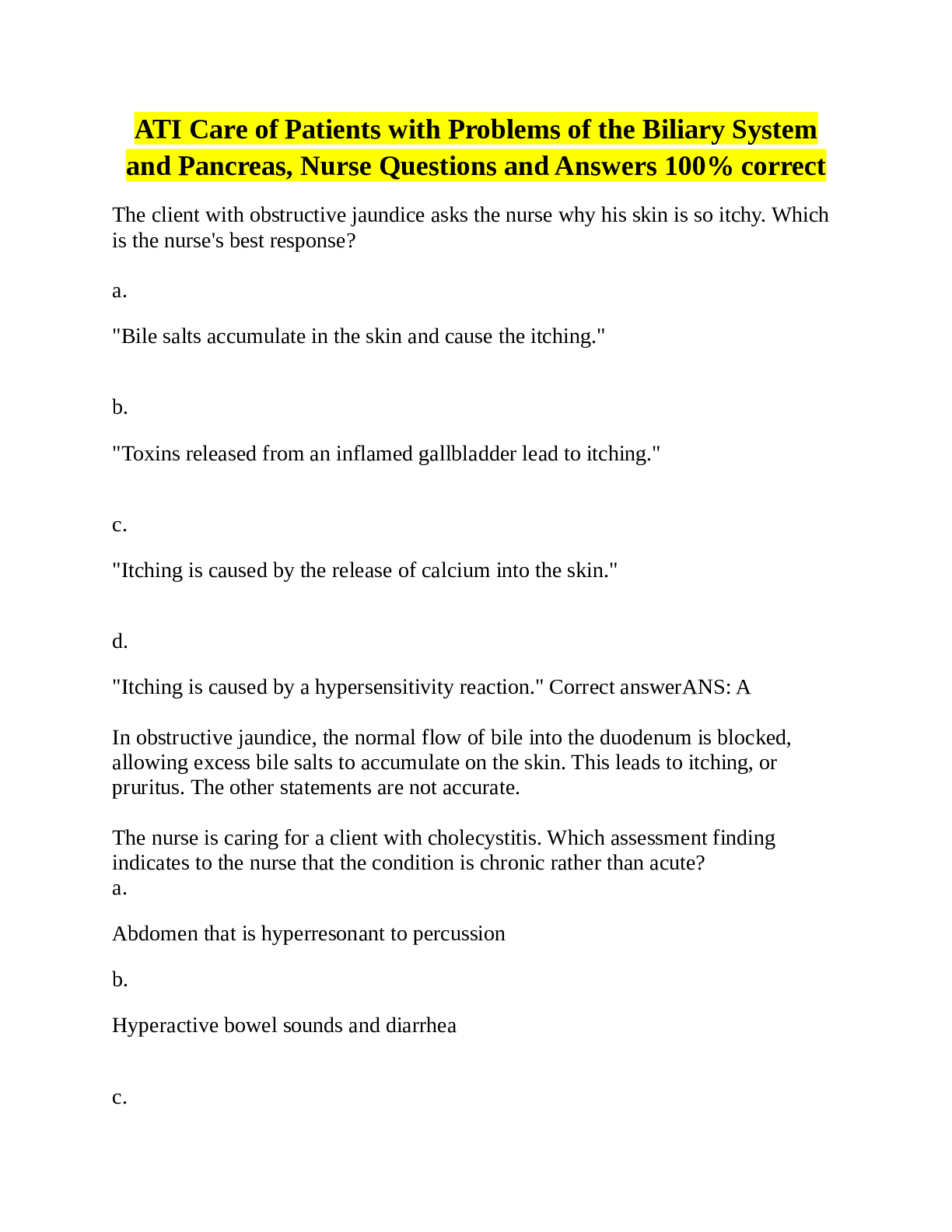Management > EXAM > Kaplan University, Indiana - MN 568/MN568-Unit 2 Question And Answers_100% Correct. (All)
Kaplan University, Indiana - MN 568/MN568-Unit 2 Question And Answers_100% Correct.
Document Content and Description Below
MN568-Unit 2 Question 1 2 / 2 points Which of the following antibiotics provides the best coverage in acute or chronic sinusitis when gram-negative organisms are suspected? Question options: a... ) Penicillin V b) Amoxicillin c) Levofloxacin d) Clindamycin Question 2 2 / 2 points A 65-year-old man presents to the clinician with complaints of increasing bilateral peripheral vision loss, poor night vision, and frequent prescription changes that started 6 months previously. Recently, he has also been seeing halos around lights. The clinician suspects chronic open-angle glaucoma. Which of the following statements is true concerning the diagnosis of chronic open-angle glaucoma? Question options: a) The presence of increased intraocular pressure measured by tonometry is definitive for the diagnosis of open-angle glaucoma. b) The clinician can definitively diagnosis open-angle glaucoma based on the subjective complaints of the patient. c) Physical diagnosis relies on gonioscopic evaluation of the angle by an ophthalmologist. d) Early diagnosis is essential in order to reverse any damage that has occurred to the optic nerve. Question 3 0 / 2 points Joyce is taking a long-acting beta agonist for her asthma. What additional medication should she be taking? Question options: a) Inhaled corticosteroid b) Leukotriene receptor antagonist c) Systemic corticosteroid d) Methyl xanthenes Question 4 2 / 2 points You are in the park playing with your children when you see that your friend is screaming for help. Her toddler has fallen and there is a stick lodged in his eye. The child is kicking and screaming and grabbing for the stick. You: Question options: a) instruct his mother to hold him securely and not allow him to touch the stick, then carefully remove the stick from the eye. b) stabilize the foreign object and accompany the mother and child to the local ER. c) find a water fountain, hold the child to the water, and flush the eye. d) call 911. Question 5 2 / 2 points A patient presents with the following signs and symptoms: gradual onset of low-grade fever, marked fatigue, severe sore throat, and posterior cervical lymphadenopathy. Based on the signs and symptoms alone, which of the following conditions is most likely the cause? Question options: a) Gonorrhea b) Mononucleosis c) Influenza d) Herpes zoster Question 6 0 / 2 points Which of the following is an example of sensorineural hearing loss? Question options: a) Perforation of the tympanic membrane b) Otosclerosis c) Cholesteatoma d) Presbycusis Question 7 0 / 2 points Which of the following statements regarding pulmonary function is true? Question options: a) Cigarette smoking accelerates the decline in pulmonary function tenfold. b) Smoking cessation can reverse most pathological changes. c) Cigarette smoking decreases mucus production. d) There is a normal age-related decline in pulmonary function. Question 8 2 / 2 points Which of the following statements regarding TST is true? Question options: a) Tests should be read 48 hours after the injection. b) The size of the TST reaction has nothing to do with erythema but is based solely on induration. c) It is a type V T cell-mediated immune response. d) The diameter of the induration is measured in centimeters. Question 9 2 / 2 points A patient presents to the clinician complaining of ear pain. On examination, the clinician finds that the patient has tenderness on traction of the pinna as well as when applying pressure over the tragus. These findings are classic signs of which condition? Question options: a) Otitis media b) Meniere’s disease c) Tinnitus d) Otitis externa Question 10 2 / 2 points An acutely presenting, erythematous, tender lump within the eyelid is called: Question options: a) Blepharitis b) Hordeolum c) Chalazion d) Iritis Question 11 0 / 2 points Fluctuations and reductions in estrogen may be a contributing factor in which type of rhinitis? Question options: a) Vasomotor rhinitis b) Rhinitis medicamentosum c) Atrophic rhinitis d) Viral rhinitis Question 12 2 / 2 points Most nosocomial pneumonias are caused by: Question options: a) Fungi b) Viruses c) Gram-negative bacteria d) Pneumococcal pneumonia Question 13 2 / 2 points You are doing a cerumen extraction and touch the external meatus of your patient’s ear. He winces and starts coughing. What is the name of this reflex? Question options: a) Baker phenomenon b) Arnold reflex c) Cough reflex d) Tragus reflex Question 14 2 / 2 points Sinusitis is considered chronic when there are episodes of prolonged inflammation with repeated or inadequately treated acute infection lasting greater than: Question options: a) 4 weeks b) 8 weeks c) 12 weeks d) 16 weeks Question 15 2 / 2 points As diabetic retinopathy progresses, the presence of ‘cotton wool’ spots can be detected. Cotton wool spots refer to: Question options: a) Nerve fiber layer infarctions b) Blood vessel proliferation c) Venous beading d) Retinal hemorrhage Question 16 2 / 2 points Which immunoglobulin mediates the type 1 hypersensitivity reaction involved in allergic rhinitis? Question options: a) IgA b) IgE c) IgG d) IgM Question 17 2 / 2 points Cydney presents with a history of asthma. She has not been treated for a while. She complains of daily but not continual symptoms, greater than 1 week and at nighttime. She has been using her rescue inhaler. Her FEV1 is 60% to 80% predicted. How would you classify her asthma severity? Question options: a) Mild intermittent b) Mild persistent c) Moderate persistent d) Severe persistent Question 18 2 / 2 points Acute angle-closure glaucoma involves a sudden severe rise in intraocular pressure. Which of the following ranges represents normal intraocular pressure? Question options: a) 0 to 7 mm Hg b) 8 to 21 mm Hg c) 22 to 40 mm Hg d) 40 to 80 mm Hg Question 19 2 / 2 points What is the first-line recommended treatment against Group A -hemolytic streptococci (GABHS), the most common cause of bacterial pharyngitis? Question options: a) Penicillin b) Quinolone c) Cephalosporin d) Macrolide Question 20 2 / 2 points Which type of stomatitis results in necrotic ulceration of the oral mucous membranes? Question options: a) Vincent’s stomatitis b) Allergic stomatitis c) Apthous stomatitis d) Herpetic stomatitis Question 21 0 / 2 points Your patient states he has a strep throat infection. Which of the following symptoms makes you consider a viral etiology instead? Question options: a) Fever b) Headache c) Exudative pharyngitis d) Rhinorrhea Question 22 0 / 2 points The clinician is assessing a patient complaining of hearing loss. The clinician places a tuning fork over the patient’s mastoid process, and when the sound fades away, the fork is placed without restriking it over the external auditory meatus. The patient is asked to let the clinician know when the sound fades away. This is an example of which type of test? Question options: a) Weber test b) Schwabach test c) Rinne test d) Auditory brainstem response (ABR) test Question 23 0 / 2 points A patient presents to the clinician with a sore throat, fever of 100.7ϒF, and tender anterior cervical lymphadenopathy. The clinician suspects strep throat and performs a rapid strep test that is negative. What would the next step be? Question options: a) The patient should be instructed to rest and increase fluid intake as the infection is most likely viral and will resolve without antibiotic treatment. b) Because the patient does not have strep throat, the clinician should start broad spectrum antibiotics in order to cover the offending pathogen. c) A throat culture should be performed to confirm the results of the rapid strep test. d) The patient should be treated with antibiotics for strep throat as the rapid strep test is not very sensitive. Question 24 2 / 2 points Which information should be included when you are teaching your patient about the use of nicotine gum? Question options: a) The gum must be correctly chewed to a softened state and then placed in the buccal mucosa. b) Patients should not eat for 30 minutes prior to or during the use of the gum. c) Initially, one piece is chewed every 30 minutes while awake. d) Acidic foods and beverages should be encouraged during nicotine therapy. Question 25 0 / 2 points Which of the following conditions is associated with cigarette smoking? Question options: a) Glaucoma b) Increased sperm quality c) Bladder cancer d) Eczema Question 26 2 / 2 points The presence of hairy leukoplakia in a person with no other symptoms of immune suppression is strongly suggestive of which type of infection? Question options: a) HSV type 2 b) HIV c) Pneumonia d) Syphilis Question 27 2 / 2 points Which subtype of cataracts is characterized by significant nearsightedness and a slow indolent course? Question options: a) Nuclear cataracts b) Cortical cataracts c) Posterior cataracts d) Immature cataracts Question 28 2 / 2 points Julie has a postnasal drip along with her cough. You assess her for: Question options: a) Asthma b) Sinusitis c) Allergic or vasomotor rhinitis d) Influenza Question 29 0 / 2 points Otitis media is considered chronic when: Question options: a) Inflammation persists more than 3 months with intermittent or persistent otic discharge. b) There are more than six occurrences of otitis media in a 1-year period. c) Otitis media does not resolve after two courses of antibiotics. d) All of the above Question 30 0 / 2 points Which of the following statements is true concerning the use of bilberry as a complementary therapy for cataracts? Question options: a) The body converts bilberry to vitamin A, which helps to maintain a healthy lens. b) Bilberry blocks an enzyme that leads to sorbitol accumulation that contributes to cataract formation in diabetes. c) Bilberry boosts oxygen and blood delivery to the eye. d) Bilberry is a good choice for patients with diabetes as it does not interact with antidiabetic drugs. Question 31 0 / 2 points Nathan, a 32-year-old policeman, has a 15-pack-a-year history of smoking and continues to smoke heavily. During every visit, he gets irate when you try to talk to him about quitting. What should you do? Question options: a) Hand him literature about smoking cessation at every visit. b) Wait until he is ready to talk to you about quitting. c) Document in the record that he is not ready to quit. d) Continue to ask him at every visit if he is ready to quit. Question 32 2 / 2 points Patients with acute otitis media should be referred to a specialist in which of the following situations? Question options: a) Concurrent vertigo or ataxia b) Failed closure of a ruptured tympanic membrane c) If symptoms worsen after 3 or 4 days of treatment d) All of the above Question 33 2 / 2 points A patient with hypertension comes in and insists that one of his new medications is causing him to cough. When looking at his list of medications, you think the cough must be from: Question options: a) Metoprolol b) Clopidogrel c) Tadalafil d) Captopril Question 34 0 / 2 points In which of the following situations would referral to a specialist be needed for sinusitis? Question options: a) Recurrent sinusitis b) Allergic sinusitis c) Sinusitis that is refractory to antibiotic therapy d) All of the above Question 35 2 / 2 points The clinician is seeing a patient complaining of red eye. The clinician suspects conjunctivitis. The presence of mucopurulent discharge suggests which type of conjunctivitis? Question options: a) Viral conjunctivitis b) Keratoconjunctivitis c) Bacterial conjunctivitis d) Allergic conjunctivitis Question 36 0 / 2 points You are using the CURB-65 clinical prediction tool to decide whether Mabel, whom you have diagnosed with community-acquired pneumonia (CAP), should be hospitalized or treated at home. Her score is 3. What should you do? Question options: a) Consider home treatment. b) Plan for a short inpatient hospitalization. c) Closely supervise her outpatient treatment. d) Hospitalize and consider admitting her to the intensive care unit. Question 37 2 / 2 points Jason, age 62, has obstructive sleep apnea. What do you think is one of his contributing factors? Question options: a) He is a recovering alcoholic of 6 years. b) His collar size is 17 inches. c) He is the only person in his family who has this. d) He is extremely thin. Question 38 2 / 2 points Jolene has breast cancer that has been staged as T1, N0, M0. What might this mean? Question options: a) The tumor size cannot be evaluated; the cancer has not spread to the lymph nodes; and the distant spread cannot be evaluated. b) The cancer is in situ; it is spreading into the lymph nodes, but the spread cannot be evaluated otherwise. c) The cancer is less than 2 cm in size and has not spread to the lymph nodes or other parts of the body. d) The cancer is about 5 cm in size; nearby lymph nodes cannot be evaluated; and there is no evidence of distant spreading. Question 39 2 / 2 points Your patient is on Therabid for his asthma. You want to maintain his serum levels between: Question options: a) 0 to 5 mcg/mL b) 5 to 10 mcg/mL c) 5 to 15 mcg/mL d) 10 to 20 mcg/mL Question 40 0 / 2 points Marta is taking TB drugs prophylactically. How do you instruct her to take them? Question options: a) Take them on an empty stomach to facilitate absorption. b) Take them with aspirin (ASA) to prevent flushing. c) Take them with ibuprofen to prevent a headache. d) Take them with food to prevent nausea. Question 41 0 / 2 points You have a patient who is a positive for Strep on rapid antigen testing (rapid strep test). You order amoxacillin after checking for drug allergies (patient is negative) but he returns 3 days later, reporting that his temperature has gone up, not down (101.5 F in office). You also note significant adenopathy, most notably in the posterior and anterior cervical chains, some hepatomegaly, and a diffuse rash. You decide: Question options: a) to refer the patient. b) that he is having an allergic response and needs to be changed to a macrolide antibiotic. c) that his antibiotic dosage is not sufficient and should be changed. d) that he possibly has mononucleosis concurrent with his strep infection. Question 42 2 / 2 points A chronic cough lasts longer than: Question options: a) 3 weeks b) 1 month c) 6 months d) 8 weeks Question 43 2 / 2 points Supplemental oxygen for how many hours per day has been shown to improve the mortality associated with COPD? Question options: a) 3 to 5 hours b) 6 to 10 hours c) 11 to 14 hours d) 15 to 18 hours Question 44 2 / 2 points The most significant precipitating event leading to otitis media with effusion is: Question options: a) Pharyngitis b) Allergies c) Viral upper respiratory infection (URI) d) Perforation of the eardrum Question 45 2 / 2 points African American patients seem to have a negative reaction to which of the following asthma medications? Question options: a) Inhaled corticosteroids b) Long-term beta-agonist bronchodilators c) Leukotriene receptor agonists d) Oral corticosteroids Question 46 2 / 2 points Why do you suspect that your patient may have a decreased response to the tuberculin skin test (TBT)? Question options: a) She is on a high-protein diet. b) She is an adolescent. c) She has been on long-term corticosteroid therapy. d) She just got over a cold. Question 47 2 / 2 points Which of the following medications used in the treatment of glaucoma works by constricting the pupils to open the angle and allow aqueous fluid to escape? Question options: a) Pilocarpine b) Timolol c) Brinzolamide d) Acetazolamide Question 48 2 / 2 points Which ethnic group has the highest lung cancer incidence and mortality rates? Question options: a) African American men b) Scandinavian men and women c) Caucasian women d) Asian men Question 49 2 / 2 points The barrel chest characteristic of emphysema is a result of: Question options: a) Chronic coughing b) Hyperinflation c) Polycythemia d) Pulmonary hypertension Question 50 2 / 2 points The most common cause of CAP is? Question options: a) Streptococcus pneumoniae b) Klebsiella pneumoniae c) Legionella pneumoniae d) Pseudomonas aeruginosa [Show More]
Last updated: 1 year ago
Preview 1 out of 25 pages
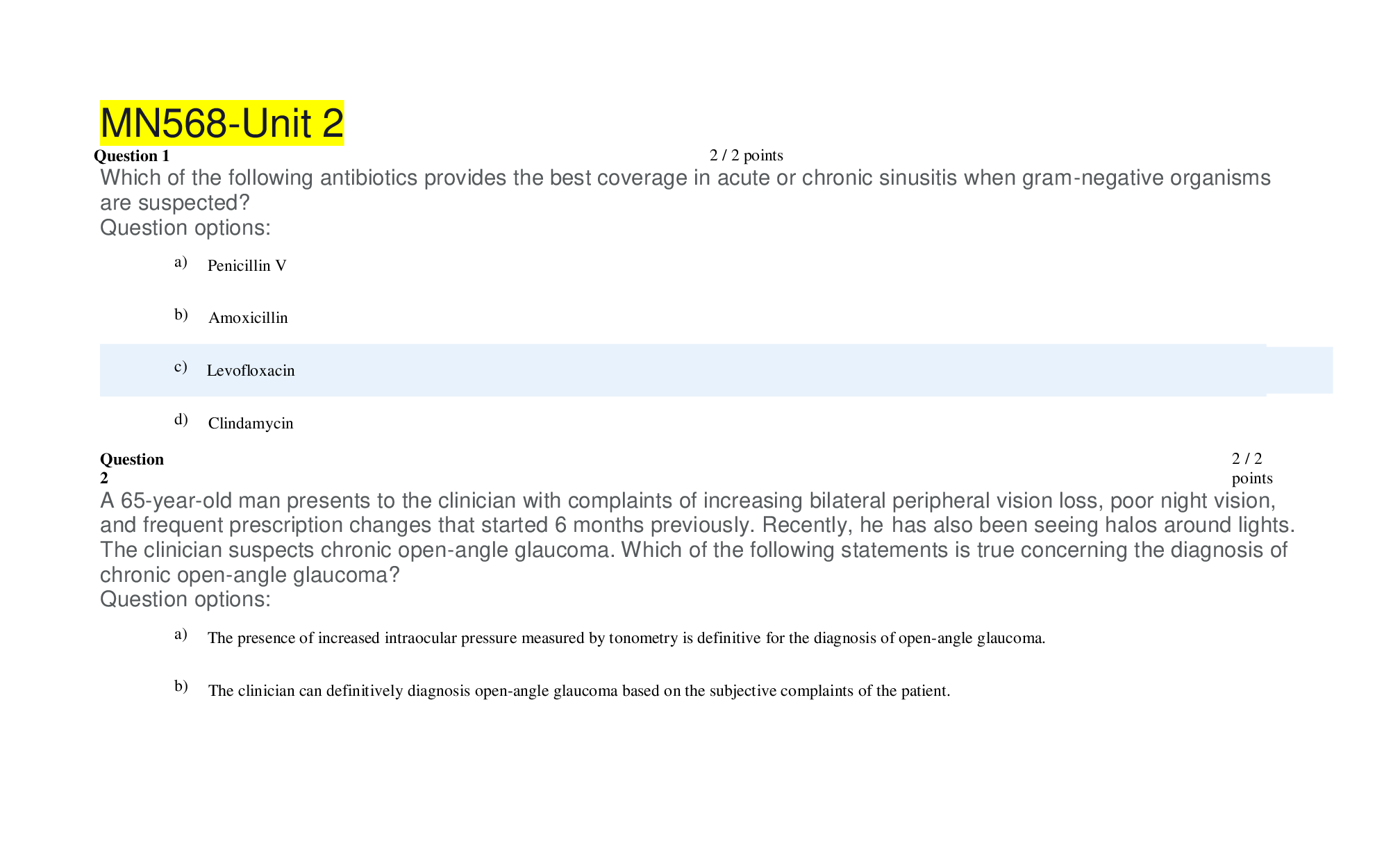
Reviews( 0 )
Document information
Connected school, study & course
About the document
Uploaded On
Aug 05, 2020
Number of pages
25
Written in
Additional information
This document has been written for:
Uploaded
Aug 05, 2020
Downloads
0
Views
28

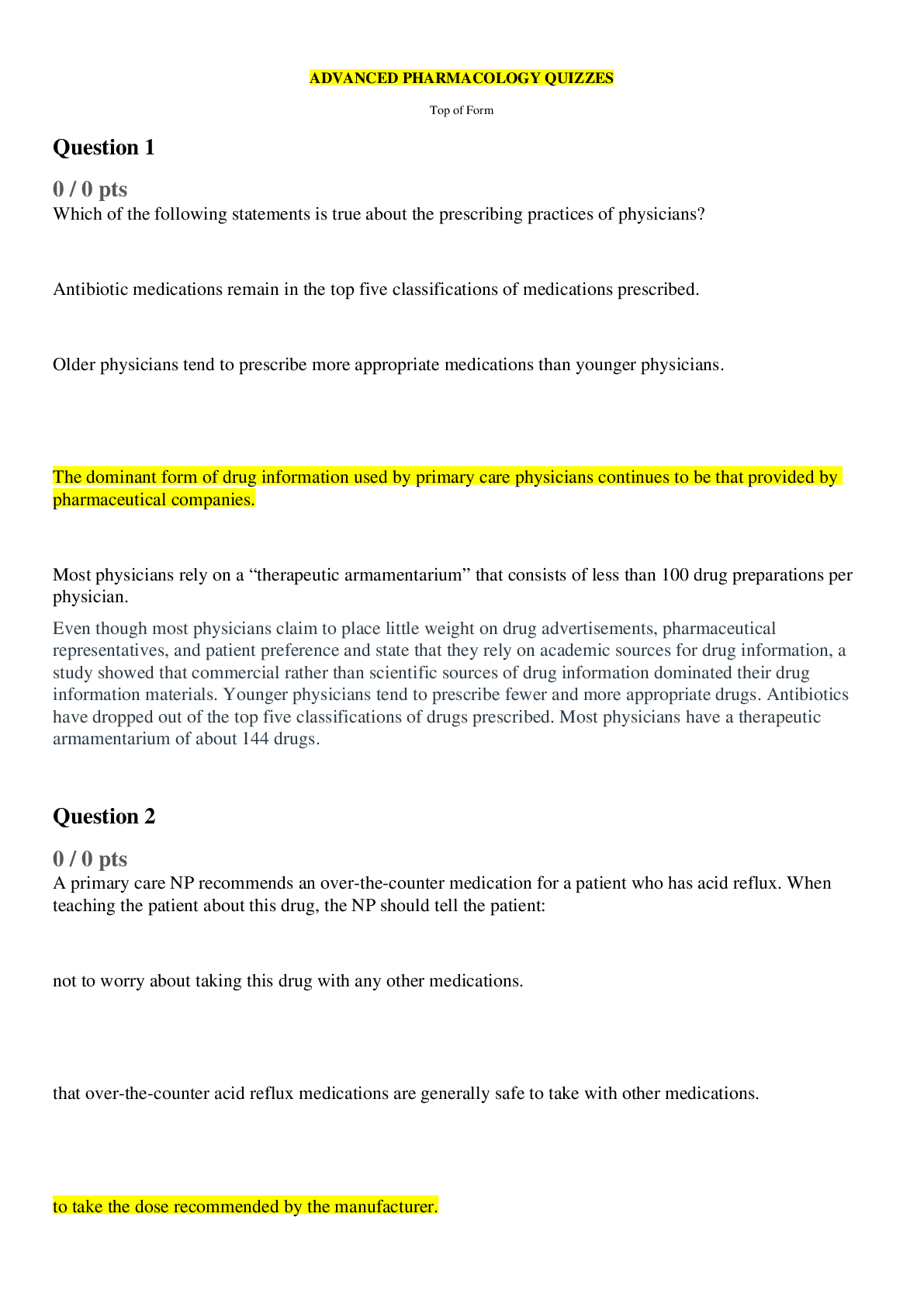
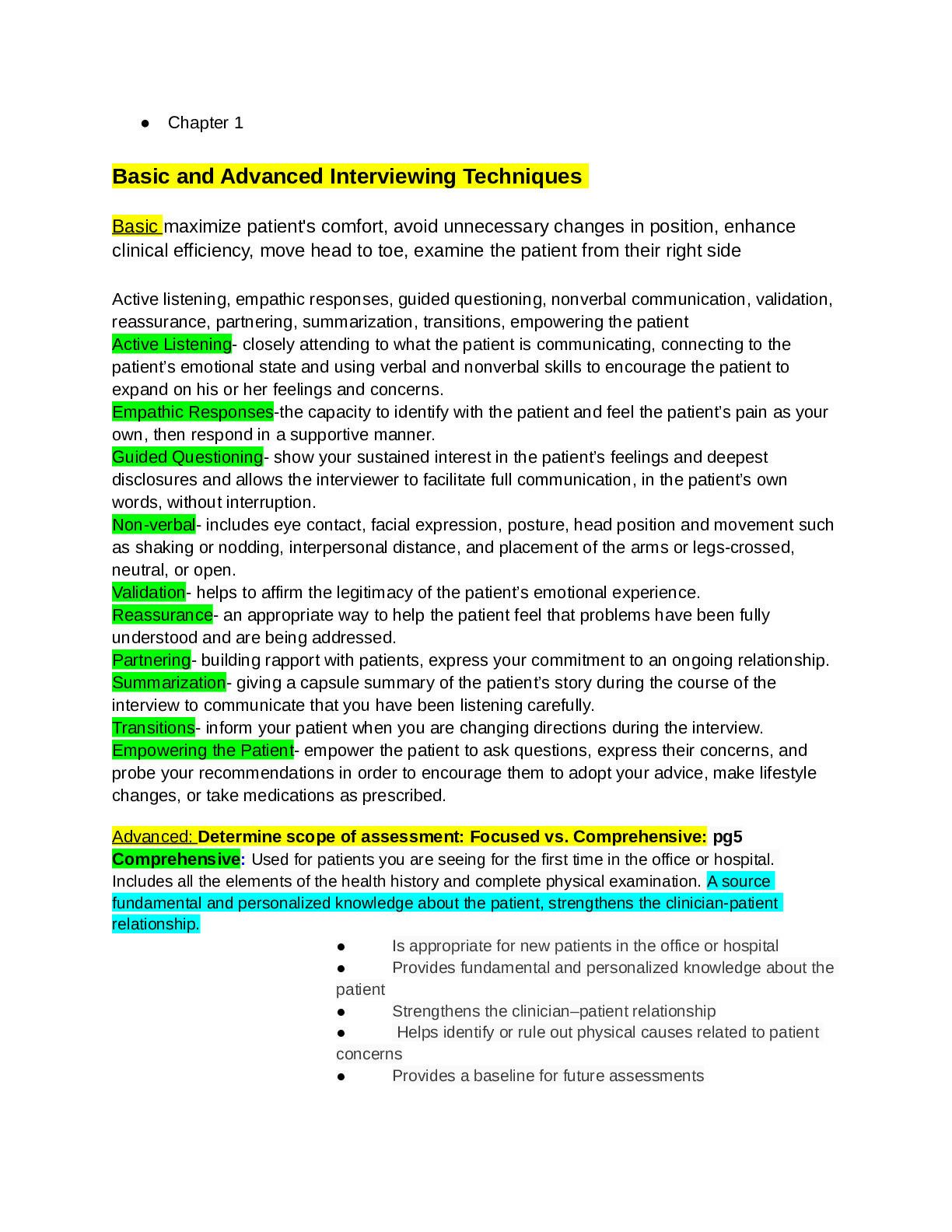
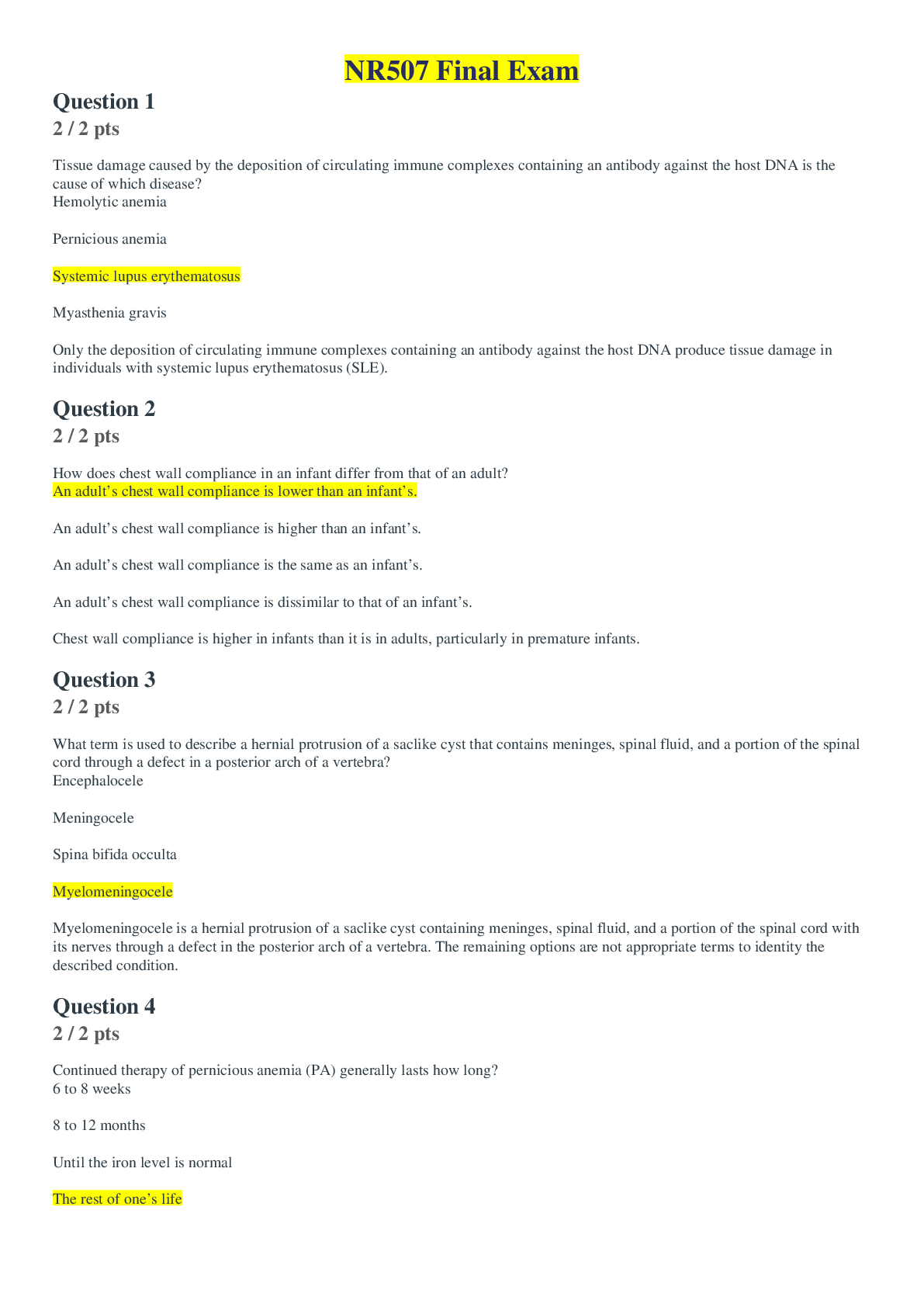
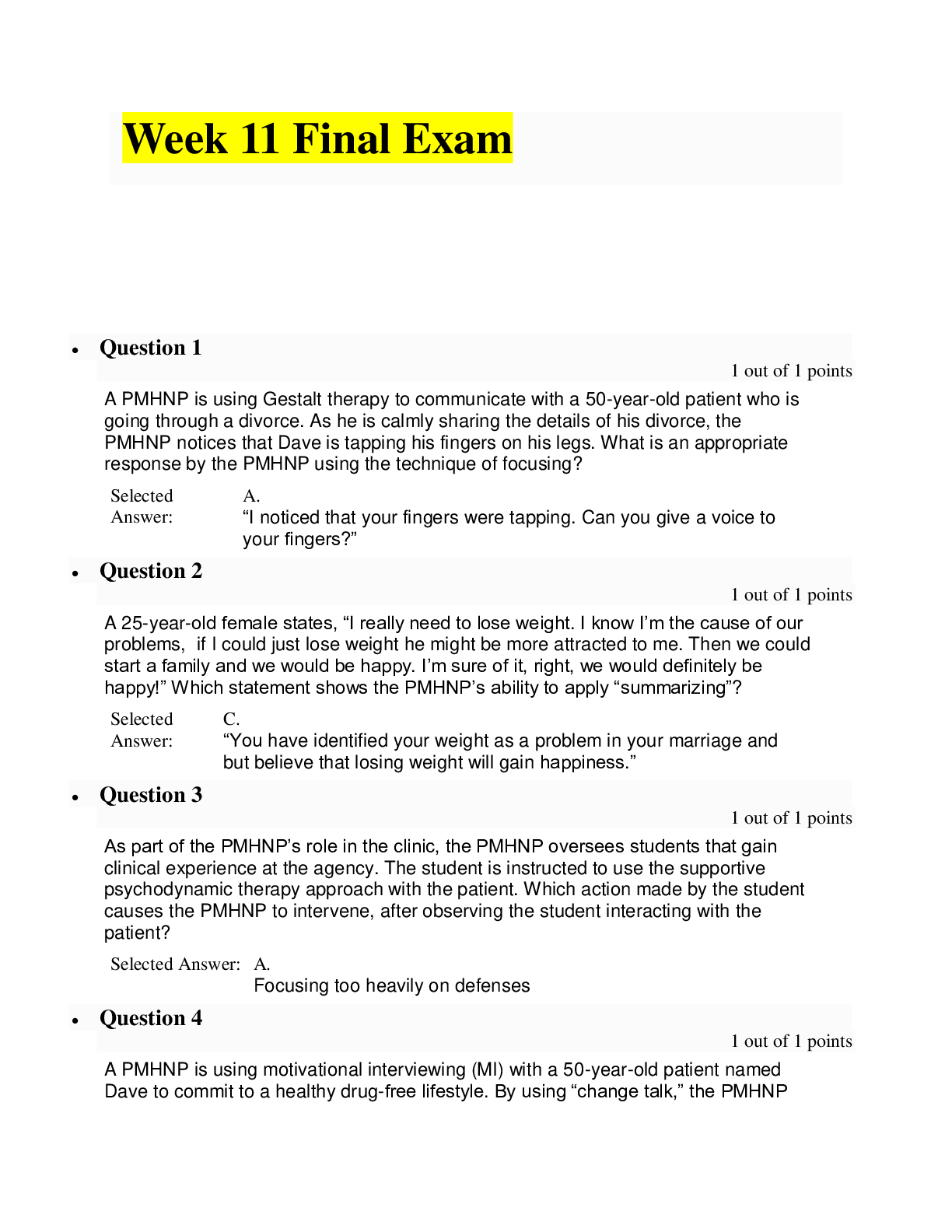
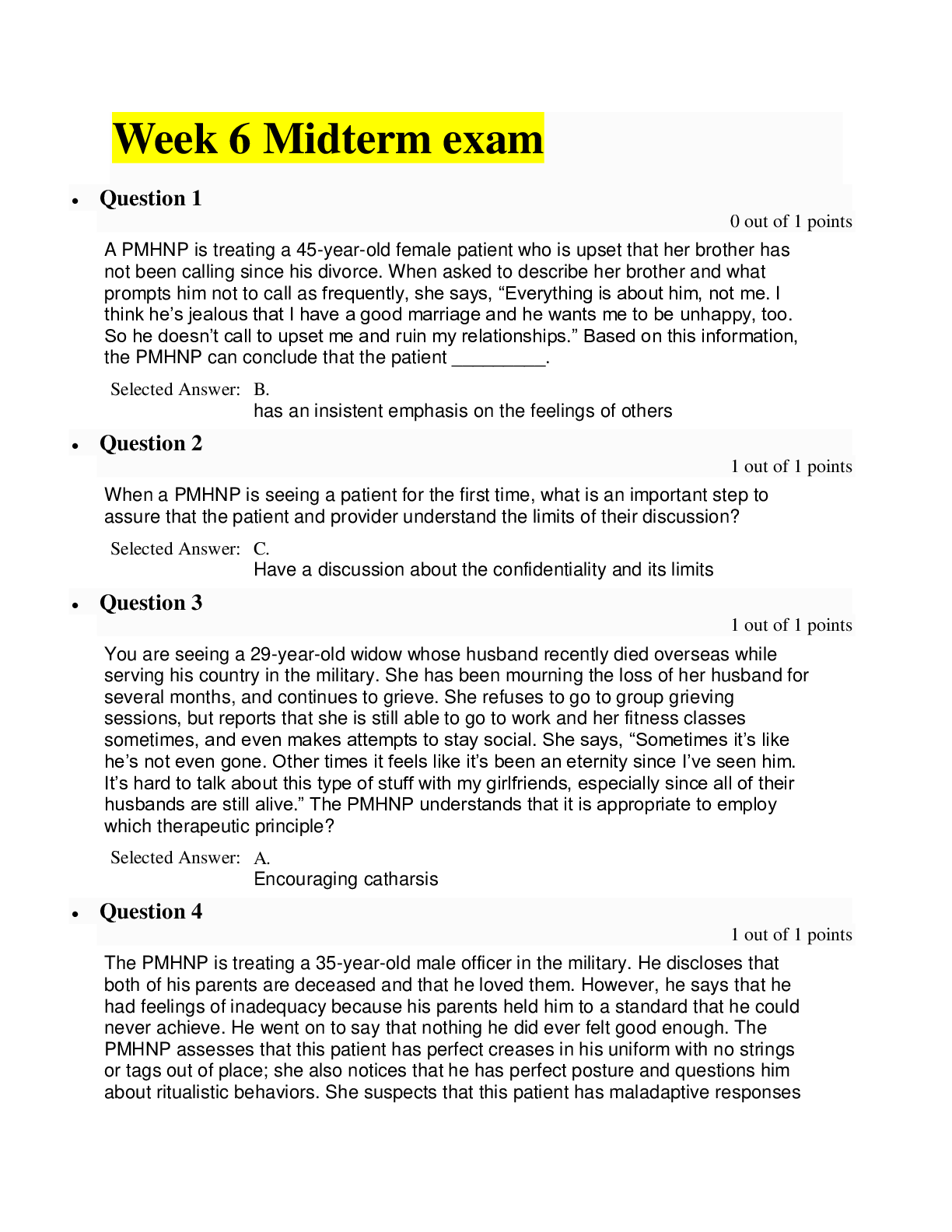
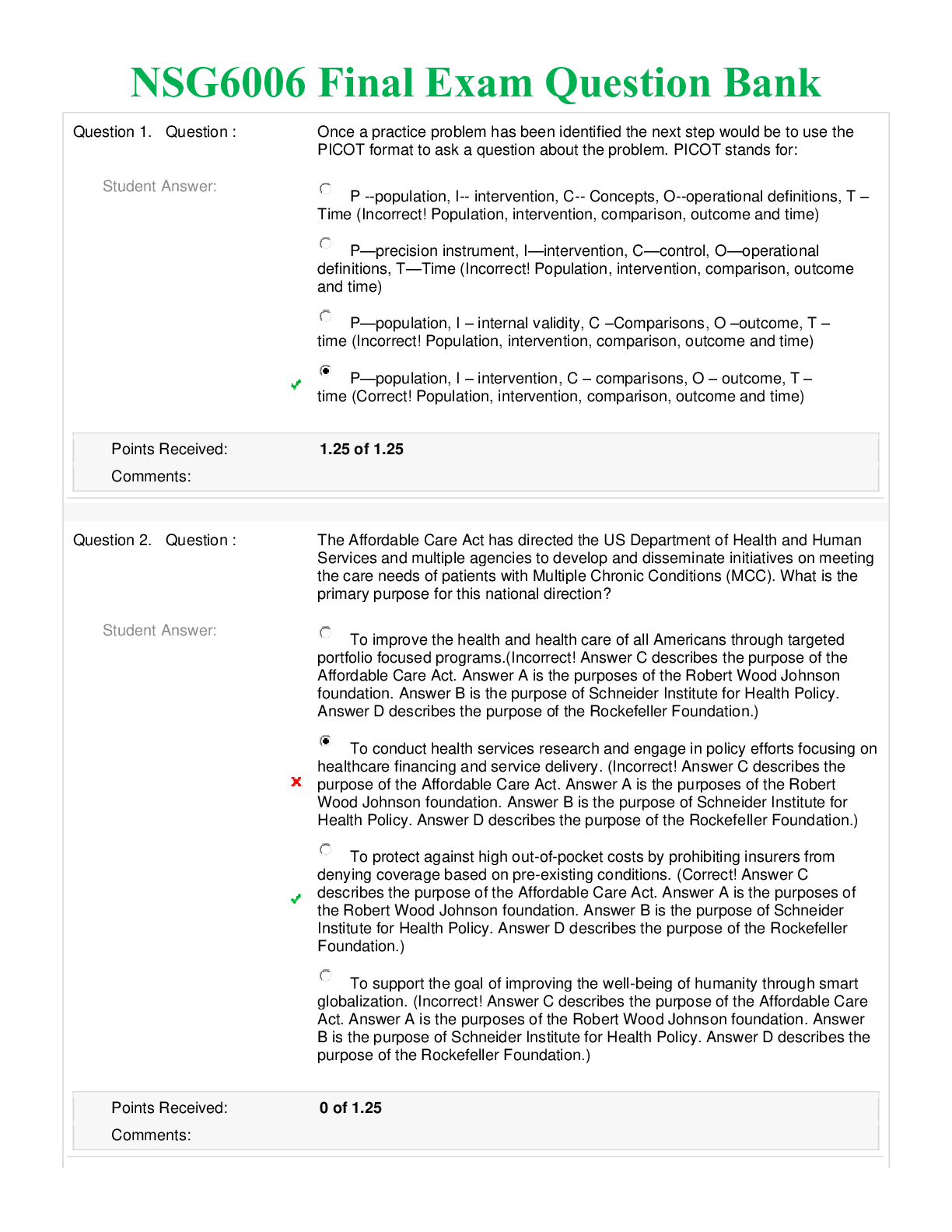
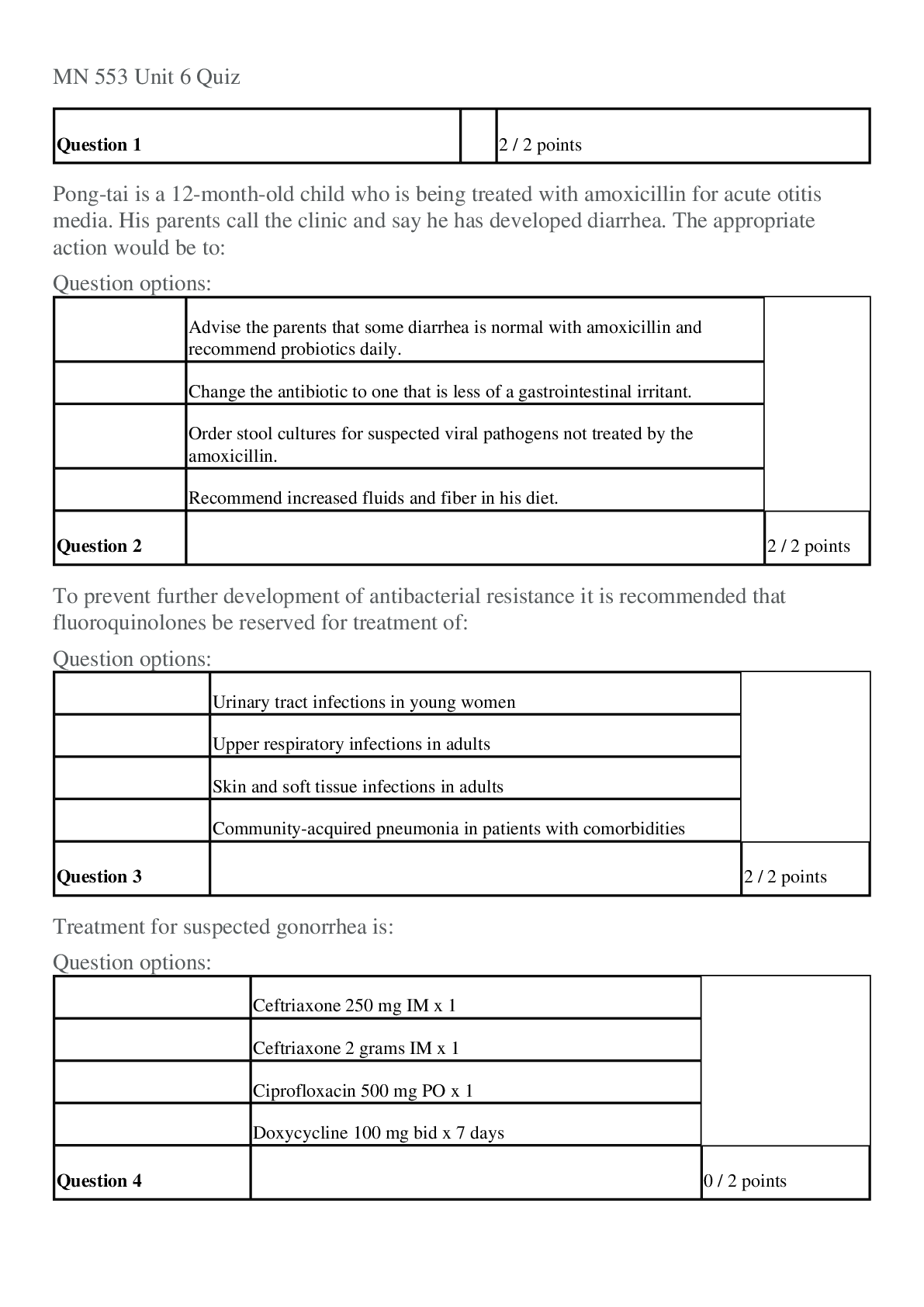
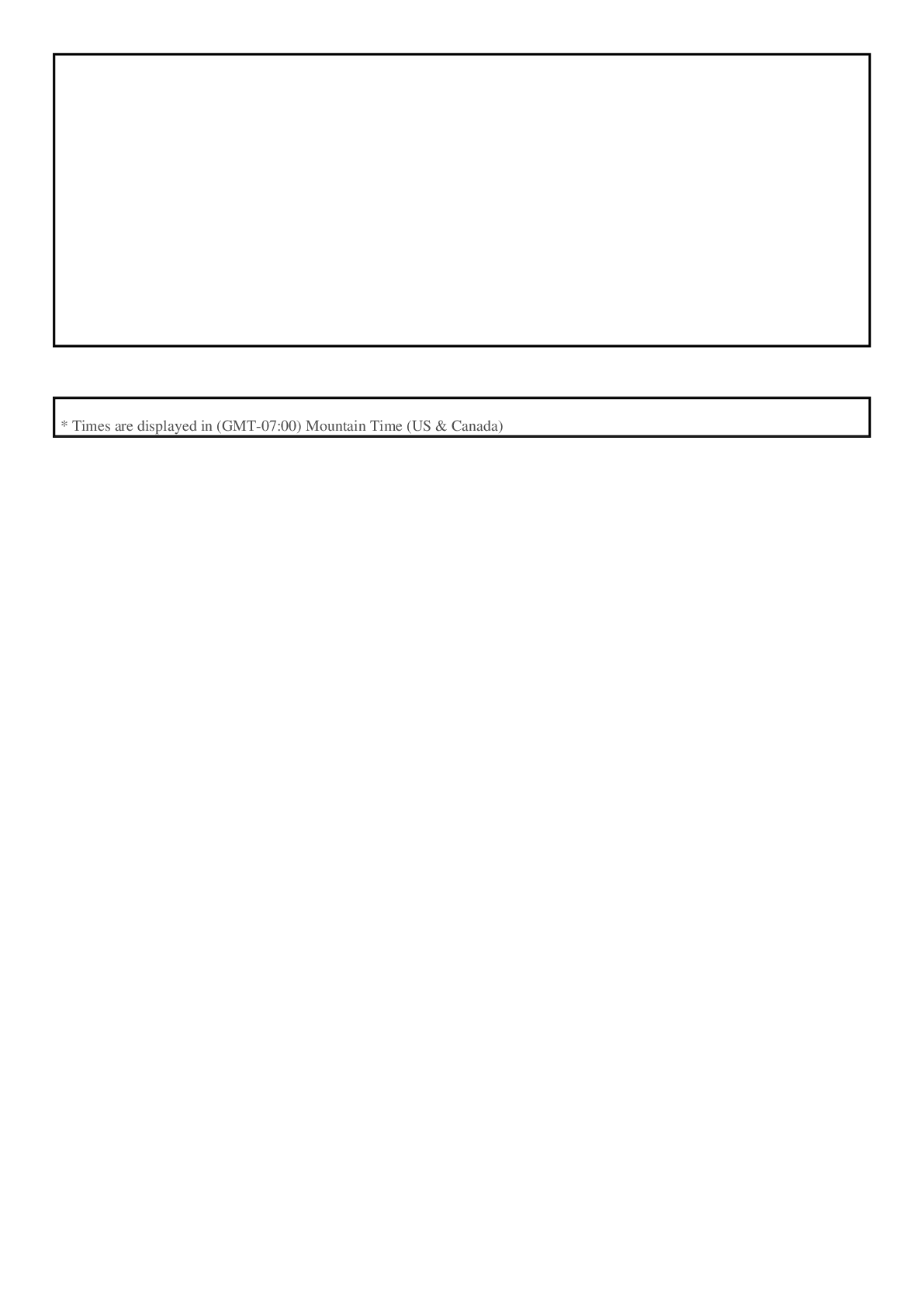

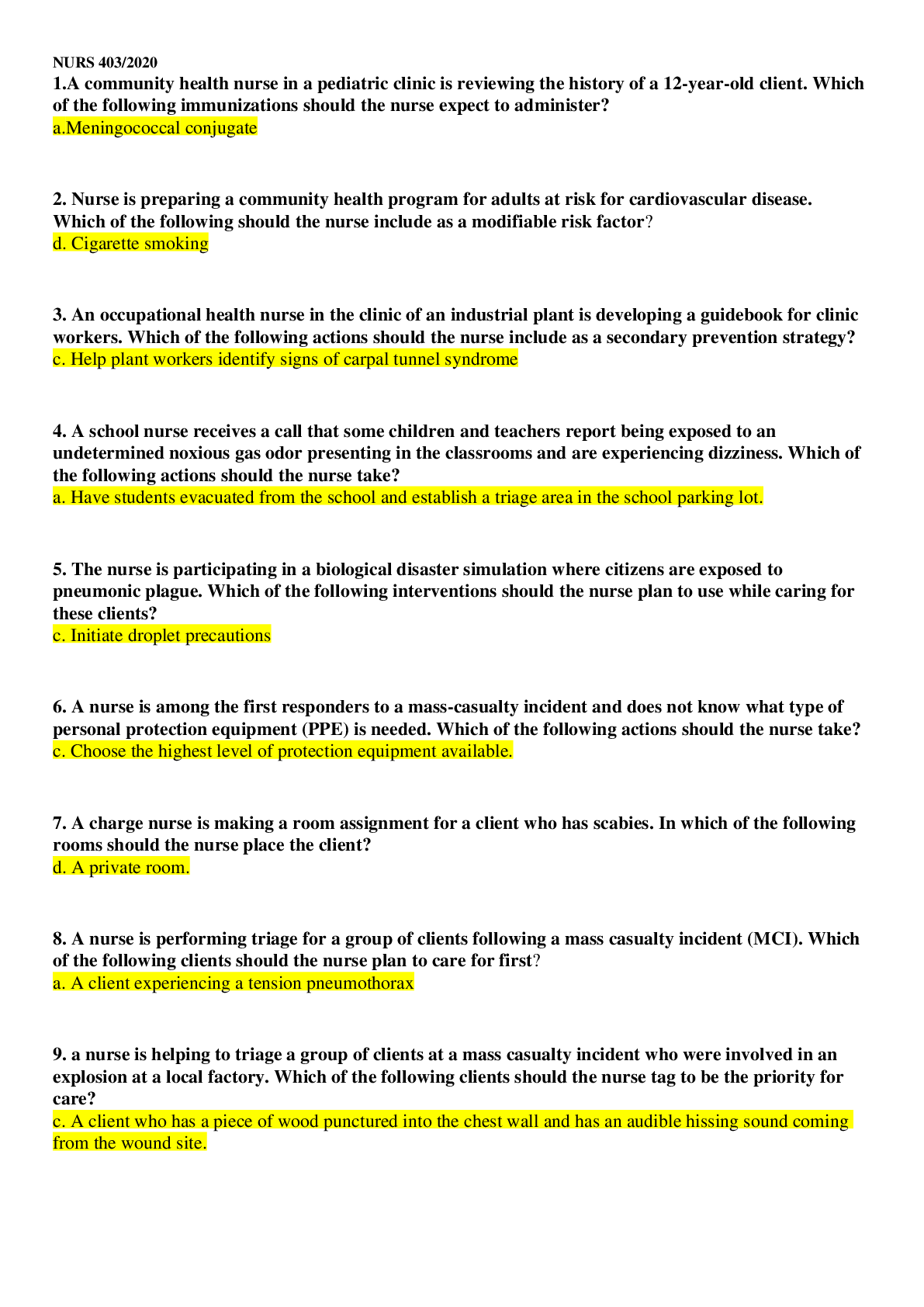
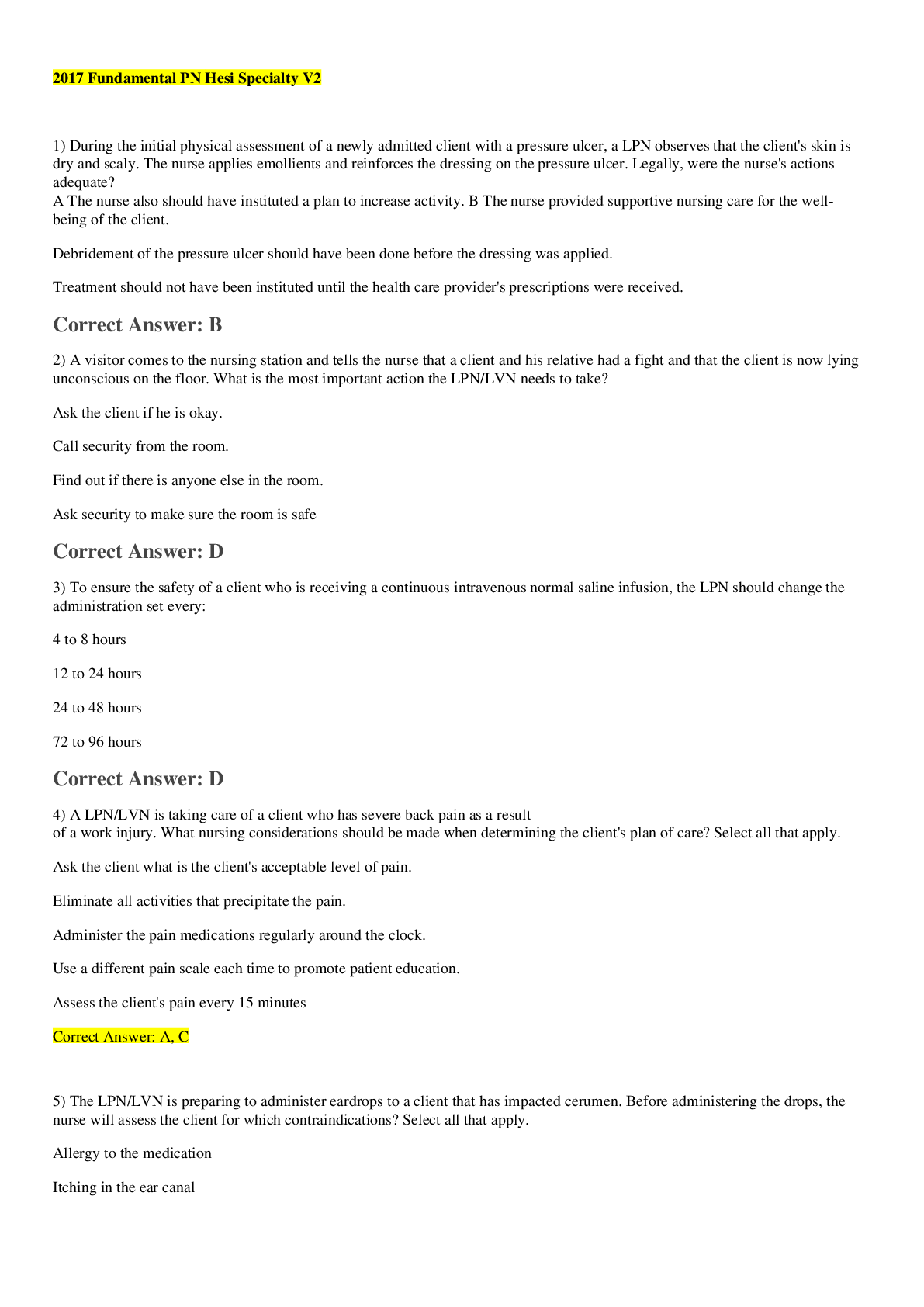
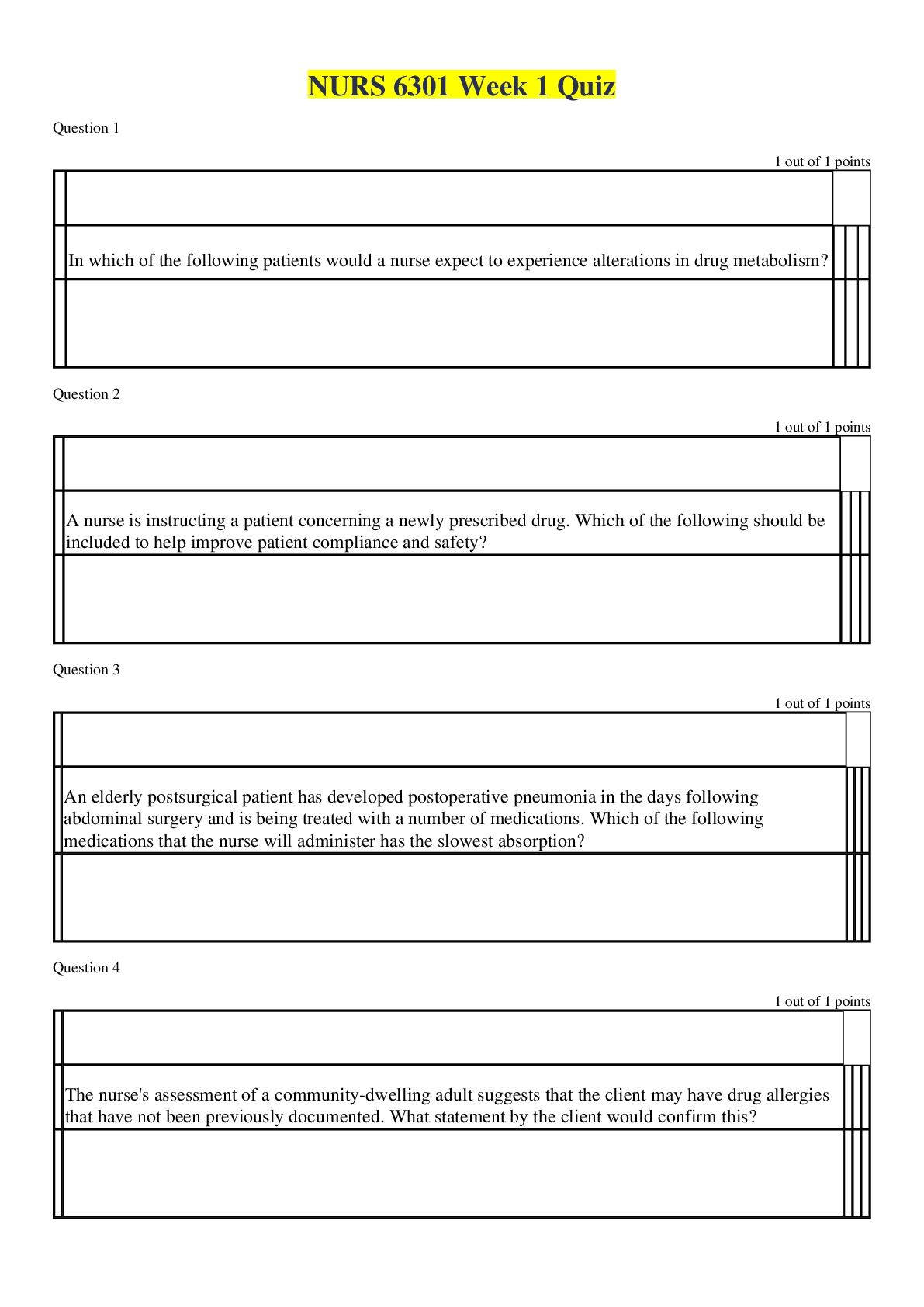
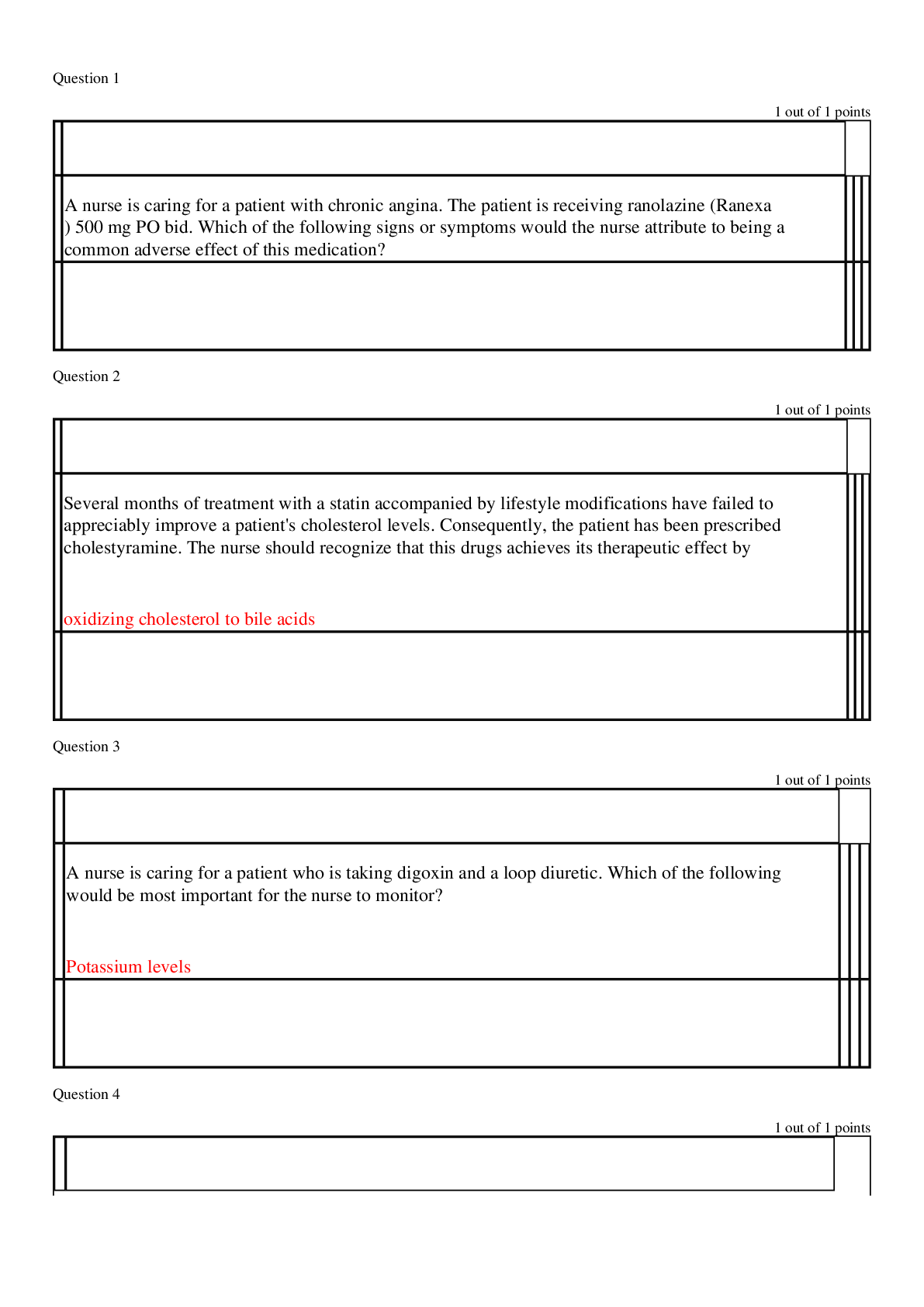
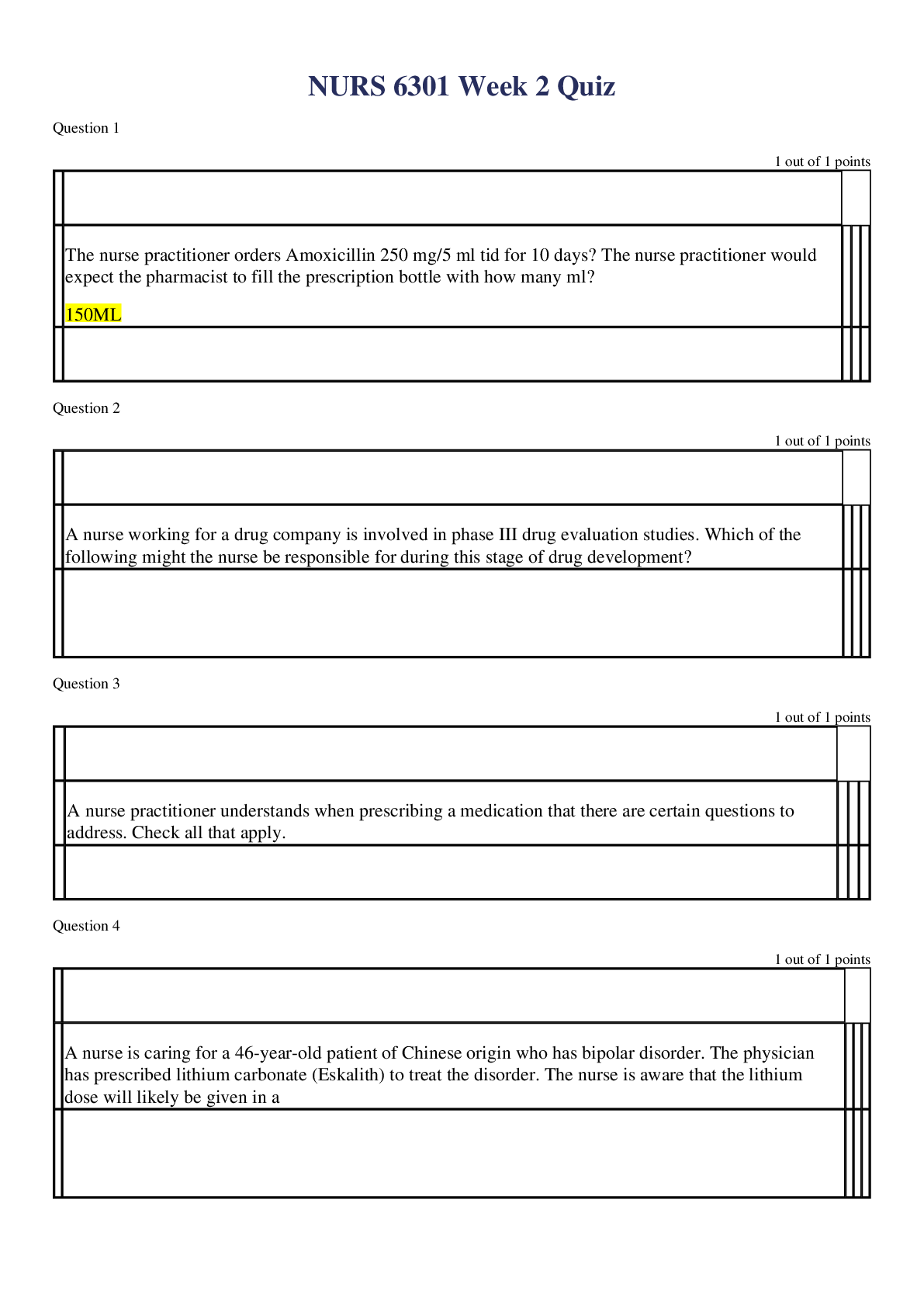
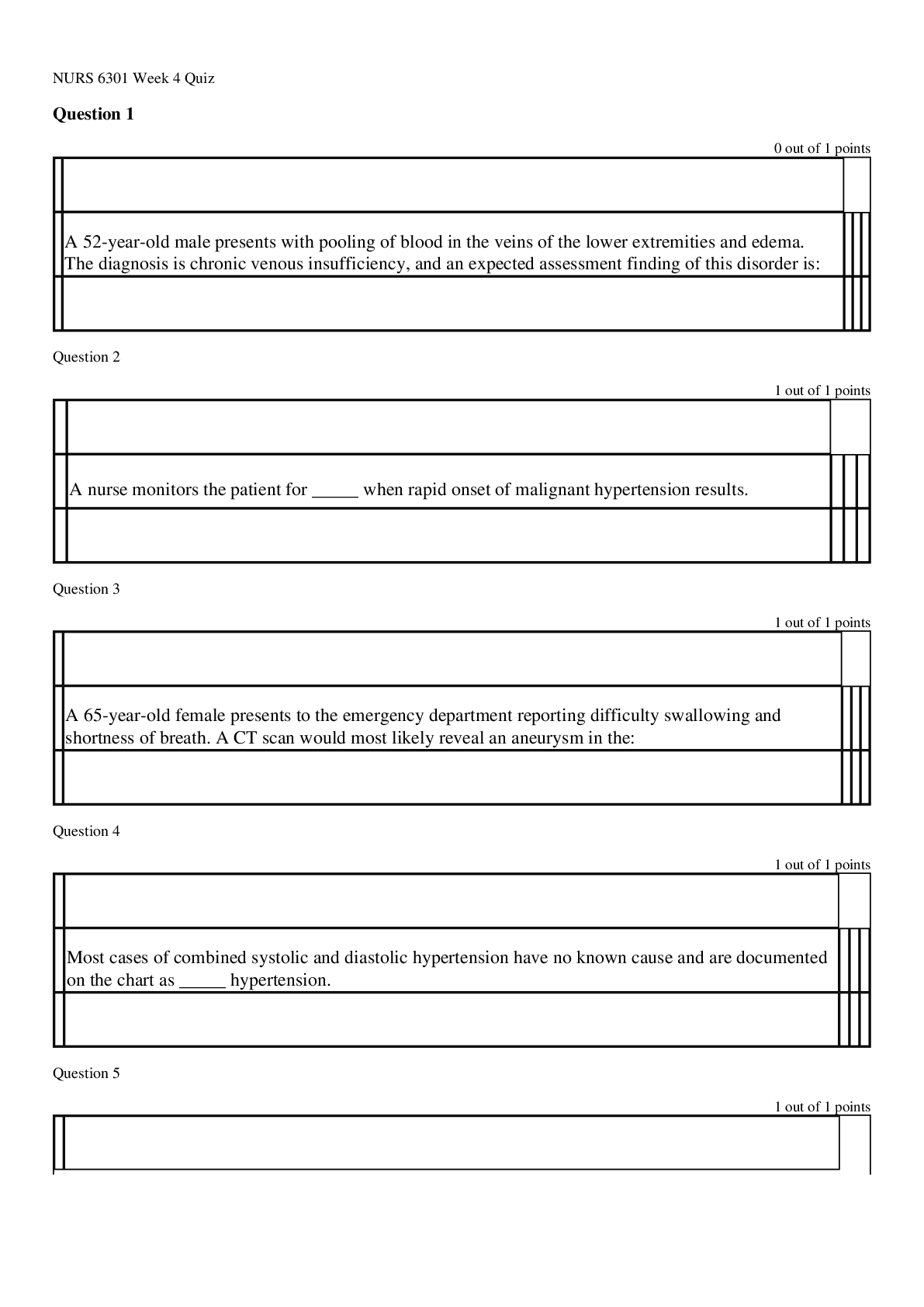
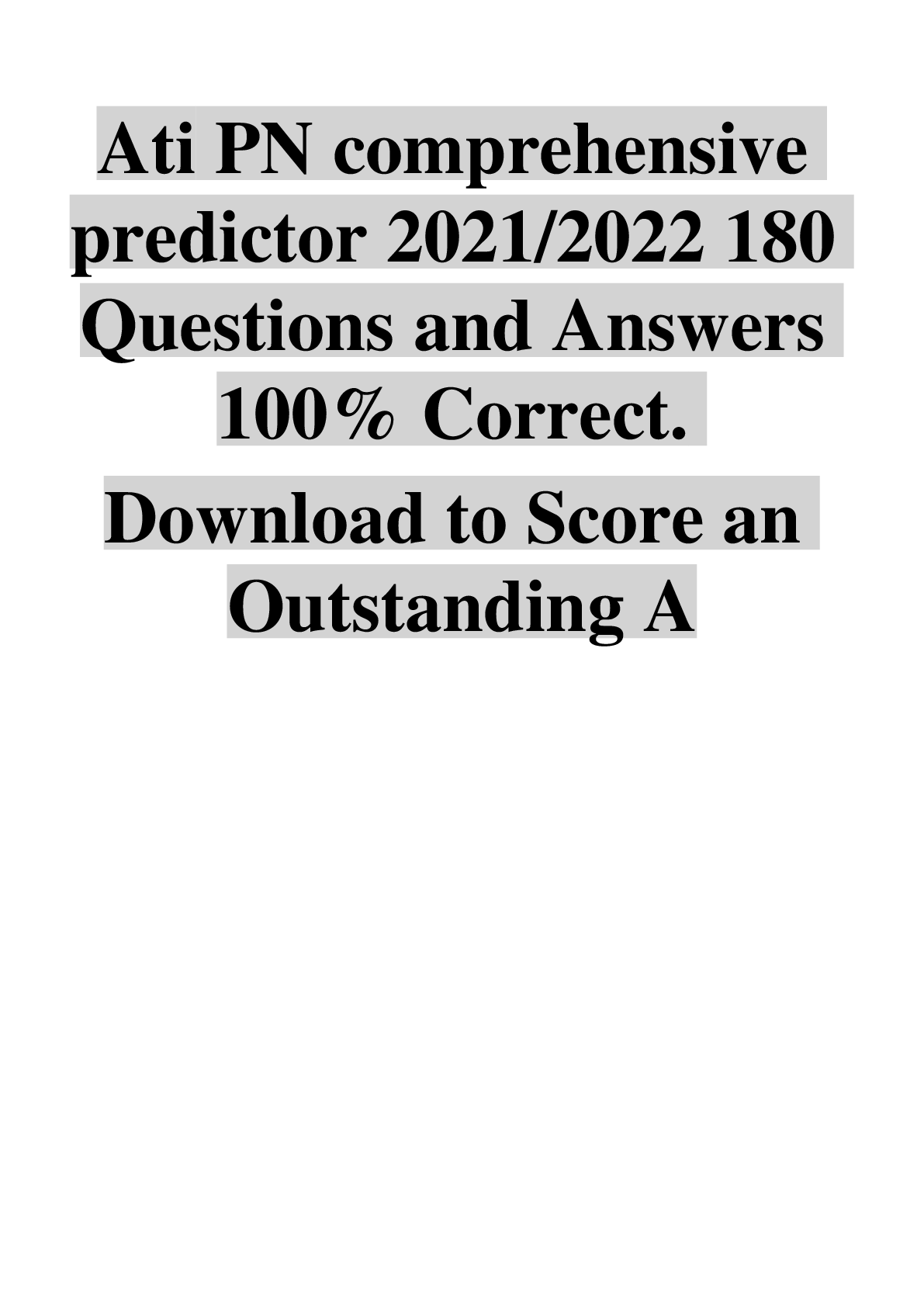
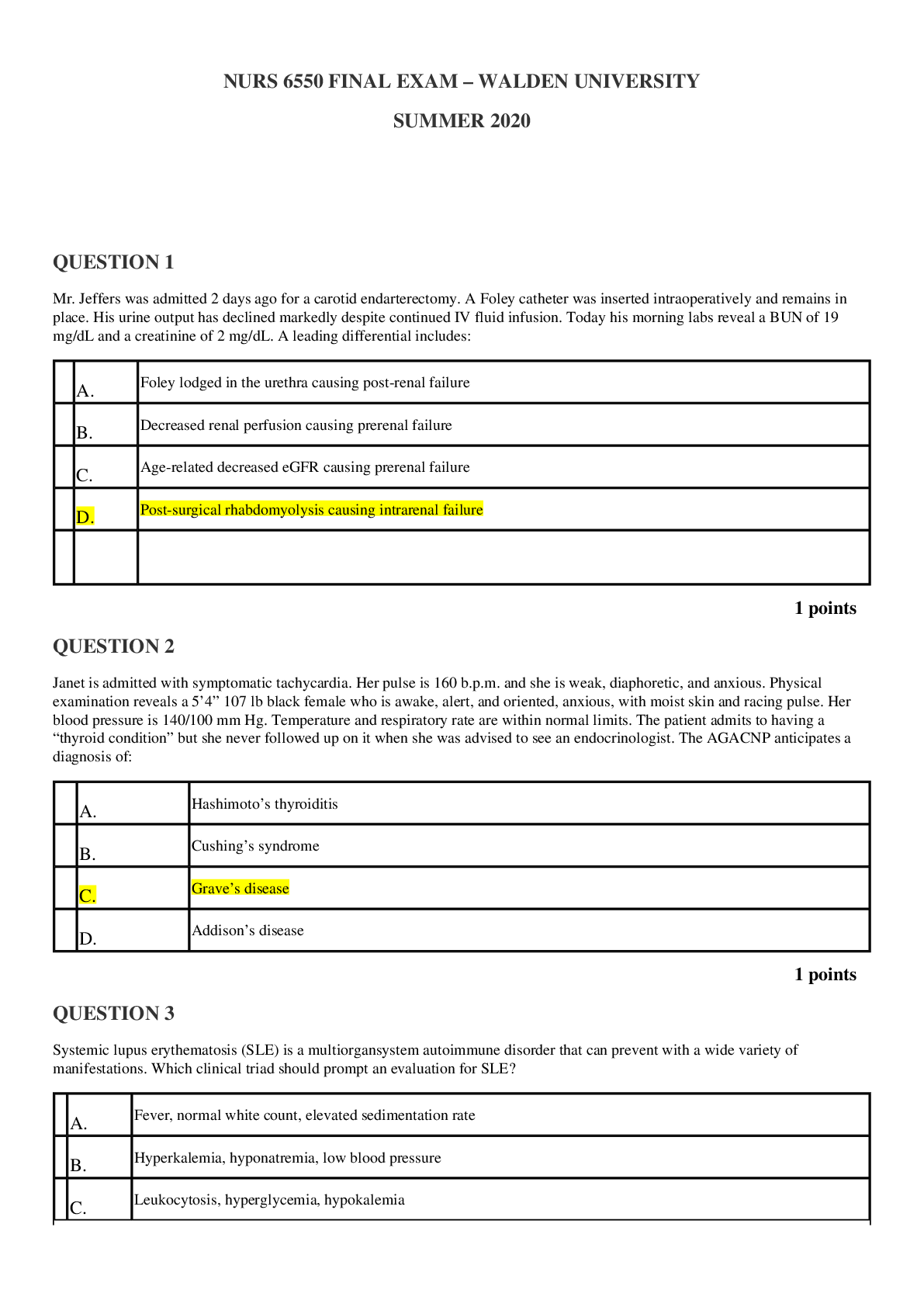



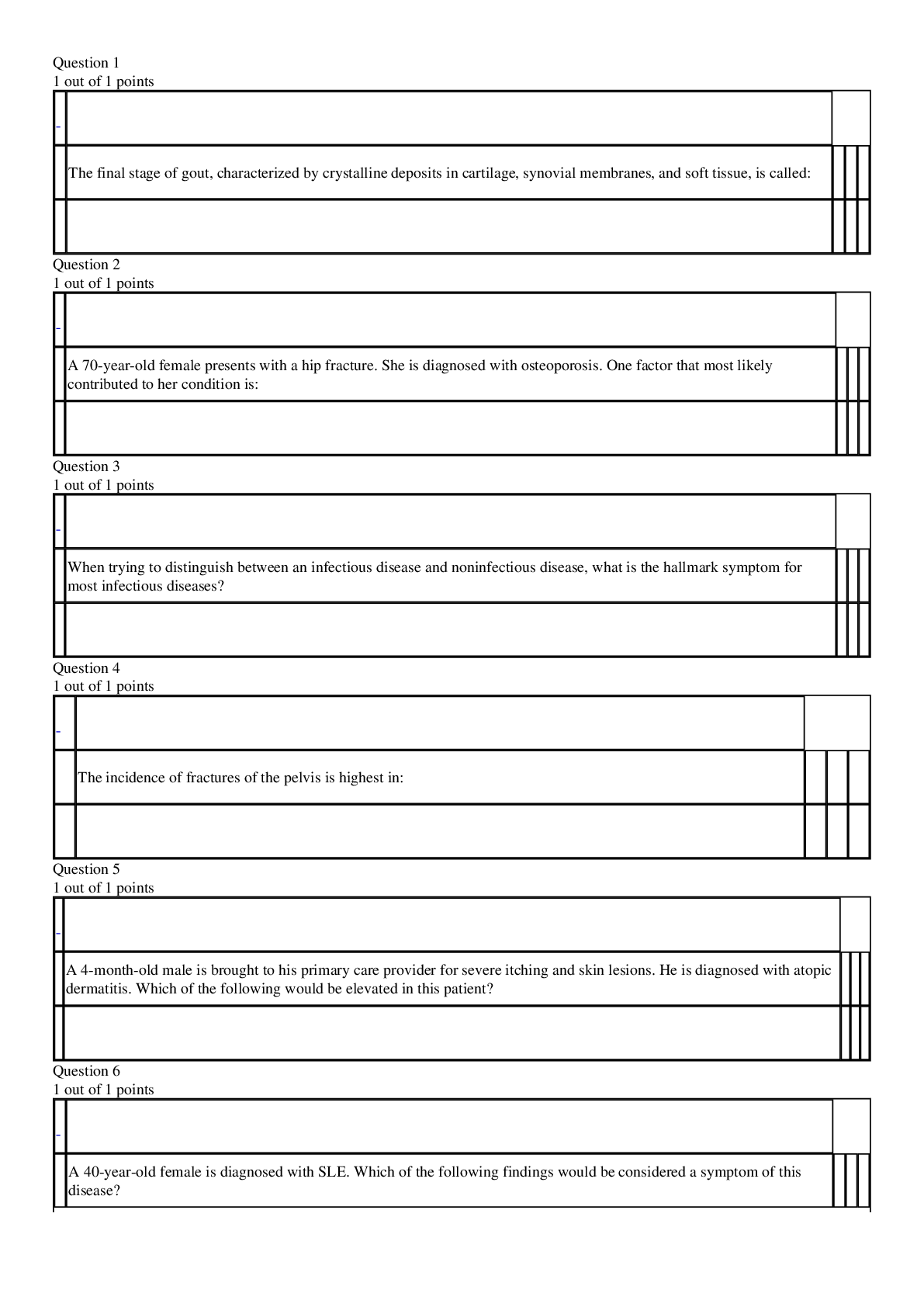
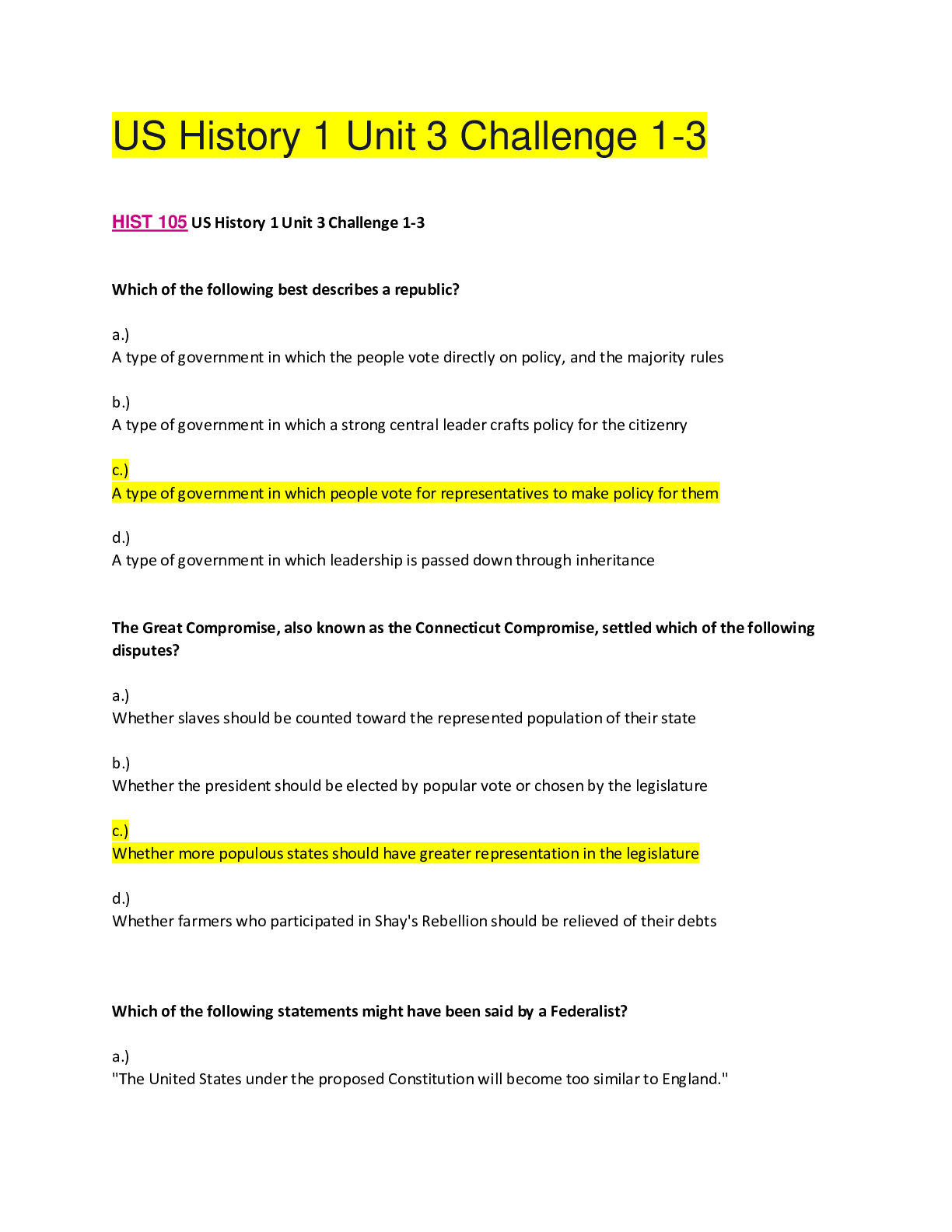
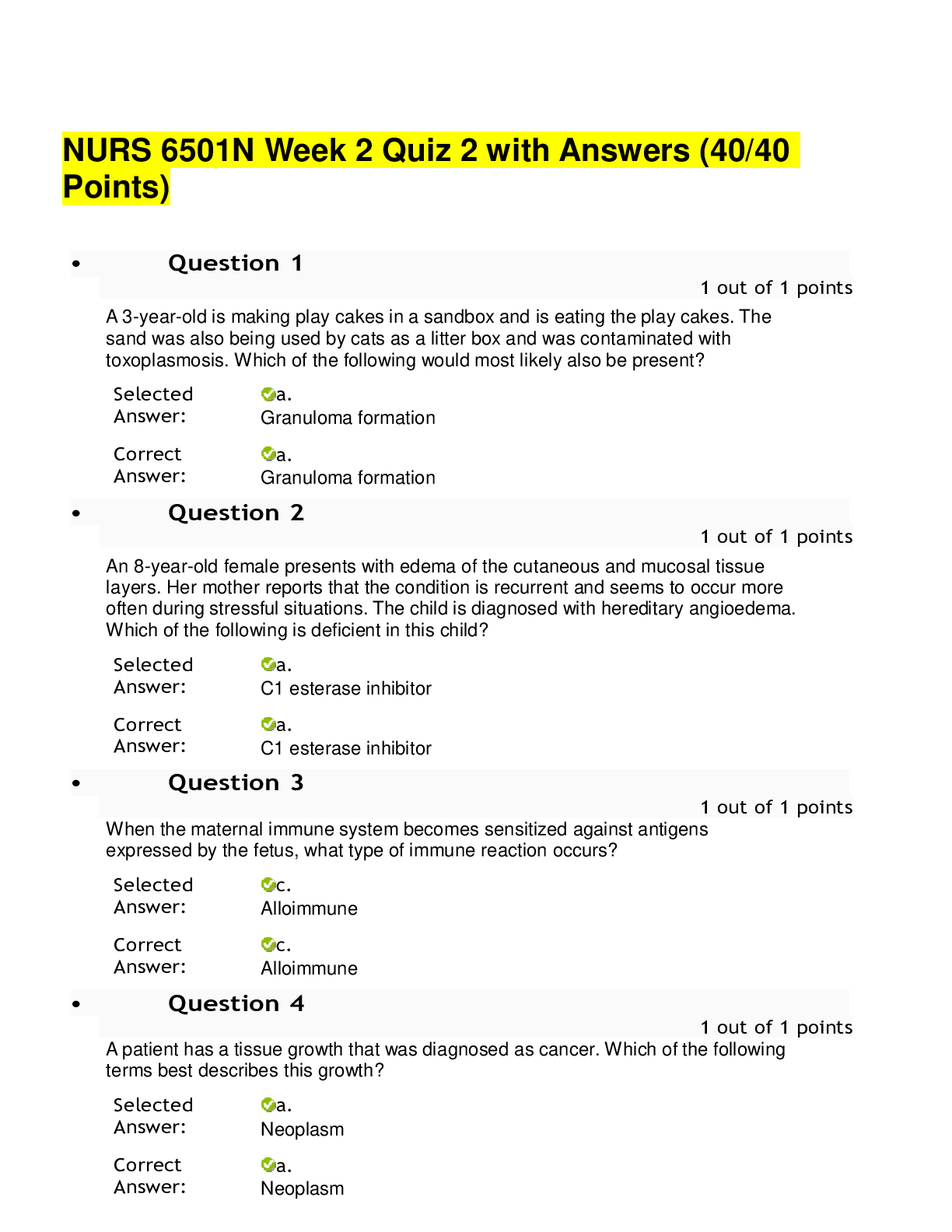
.png)

